Udacity DeepRL project 1: Navigation - Full post
Using DQN to solve the Banana environment from ML-Agents
This is an accompanying post for the submission of the Project 1: navigation from the Udacity Deep Reinforcement Learning Nanodegree, which consisted on building a DQN-based agent to navigate and collect bananas from the Banana Collector environment from Unity ML-Agents.
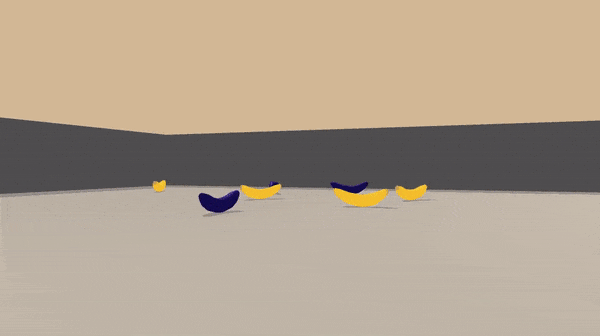
The following are the topics to be covered in this post:
- Description of the Banana Collector Environment.
- Setting up the dependencies to run the accompanying code.
- An overview of the DQN algorithm.
- DQN Implementation.
- Testing and choosing hyperparameters.
- Results and discussion
- An overview of the improvements to vanilla DQN
- Some preliminary tests of the improvements
- Final remarks and future improvements
1. Description of the Banana Collector Environment
The environment chosen for the project was a modified version of the Banana Collector Environment from the Unity ML-Agents toolkit. The original version can be found here, and our version consists of a custom build provided by Udacity with the following description:
- A single agent that can move in a planar arena, with observations given by a set of distance-based sensors and some intrinsic measurements, and actions consisting of 4 discrete commands.
- A set of NPCs consisting of bananas of two categories: yellow bananas, which give the agent a reward of +1, and purple bananas, which give the agent a reward of -1.
- The task is episodic, with a maximum of 300 steps per episode.
1.1 Agent observations
The observations the agent gets from the environment come from the agent's linear velocity in the plane (2 entries), and a set of 7 ray perceptions. These ray perceptions consist of rays shot in certain fixed directions from the agent. Each of these perceptions returns a vector of 5 entries each, whose values are explained below:
- The first 4 entries consist of a one-hot encoding of the type of object the ray hit, and these could either be a yellow banana, a purple banana, a wall or nothing at all.
- The last entry consist of the percent of the ray length at which the object was found. If no object is found at least at this maximum length, then the 4th entry is set to 1, and this entry is set to 0.0.
Below there are two separate cases that show the ray-perceptions. The first one to the left shows all rays reaching at least one object (either purple banana, yellow banana or a wall) and also the 7 sensor readings in array form (see the encodings in the 4 first entries do not contain the none found case). The second one to the right shows all but one ray reaching an object and also the 7 sensor readings in array form (see the encodings in the 4 first entries do include the none found case for the 4th perception).
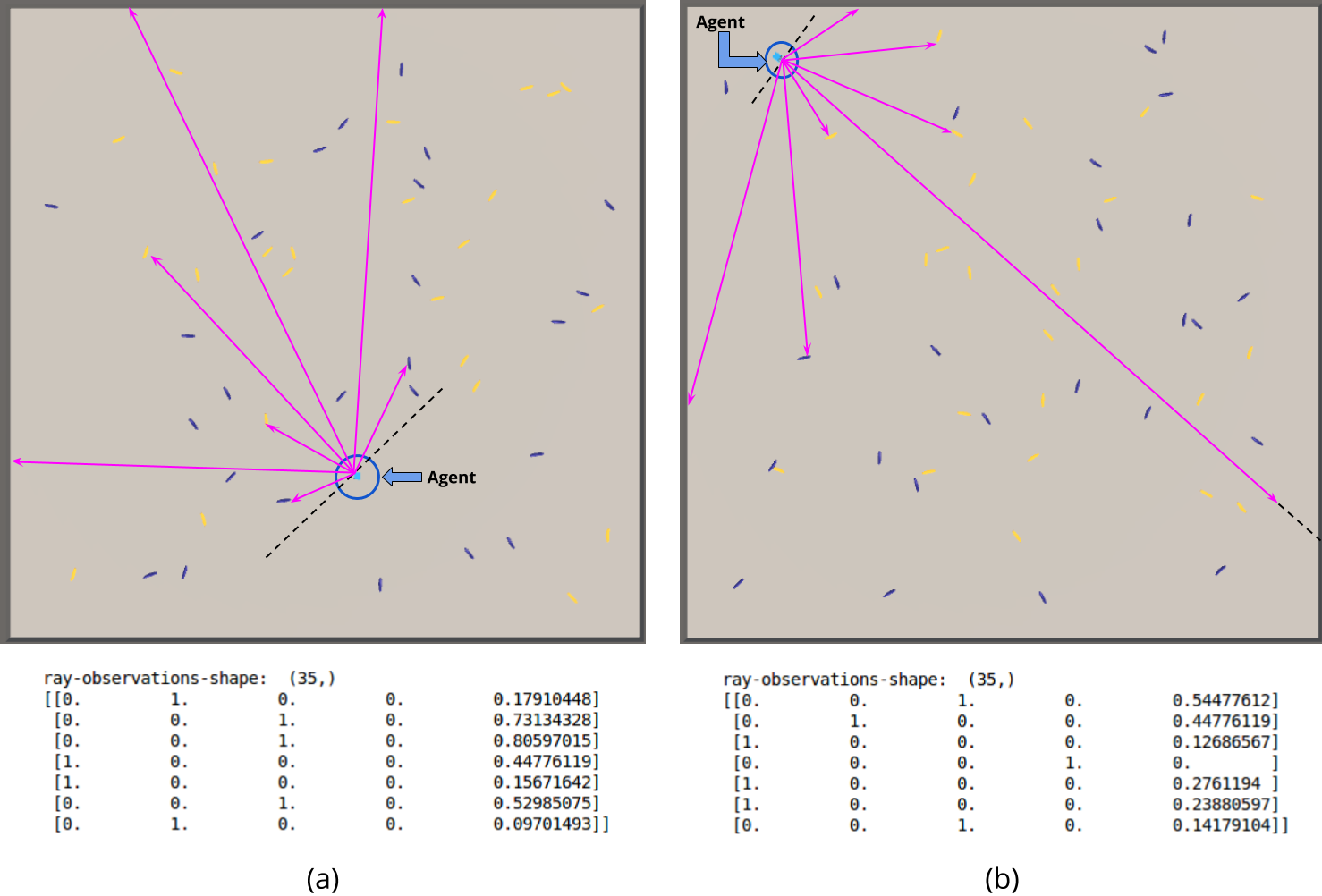
All these measurements account for an observation consisting of a vector with 37 elements. This vector observation will be the representation of the state of the agent in the environment that we will use as input to the Q-network, which will be discussed later.
Note
This representation is applicable only to our custom build (provided by Udacity), as the original Banana Collector from ML-Agents consists of a vector observation of 53 entries. The rays in the original environment give extra information about the current state of the agent (the agent in the original environment can shoot and be shot), which give 2 extra measurements, and the rays give also information about neighbouring agents (2 extra measurements per ray).
If curious, you can take a look at the C# implementation in the UnitySDK folder of the ML-Agents repository. See the 'CollectObservations' method (shown below) in the BananaAgent.cs file. This is helpfull in case you want to create a variation of the environment for other purposes other than this project.
public override void CollectObservations()
{
if (useVectorObs)
{
float rayDistance = 50f;
float[] rayAngles = { 20f, 90f, 160f, 45f, 135f, 70f, 110f };
string[] detectableObjects = { "banana", "agent", "wall", "badBanana", "frozenAgent" };
AddVectorObs(rayPer.Perceive(rayDistance, rayAngles, detectableObjects, 0f, 0f));
Vector3 localVelocity = transform.InverseTransformDirection(agentRb.velocity);
AddVectorObs(localVelocity.x);
AddVectorObs(localVelocity.z);
AddVectorObs(System.Convert.ToInt32(frozen));
AddVectorObs(System.Convert.ToInt32(shoot));
}
}
1.2 Agent actions
The actions that the agent can take consist of 4 discrete actions that serve as commands for the movement of the agent in the plane. The indices for each of these actions are the following :
- Action 0: Move forward.
- Action 1: Move backward.
- Action 2: Turn left.
- Action 3: Turn right.
Figure 3 shows these four actions that conform the discrete action space of the agent.
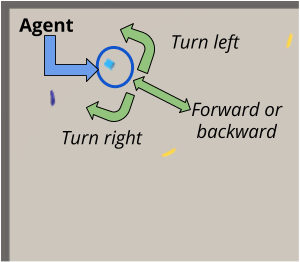
Note
These actions are applicable again only for our custom build, as the original environment from ML-Agents has even more actions, using action tables (newer API). This newer API accepts in most of the cases a tuple or list for the actions, with each entry corresponding to a specific action table (a nested set of actions) that the agent can take. For example, for the original banana collector environment the actions passed should be:
# actions are of the form: [actInTable1, actInTable2, actInTable3, actInTable4]
# move forward
action = [ 1, 0, 0, 0 ]
# move backward
action = [ 2, 0, 0, 0 ]
# mode sideways left
action = [ 0, 1, 0, 0 ]
# mode sideways right
action = [ 0, 2, 0, 0 ]
# turn left
action = [ 0, 0, 1, 0 ]
# turn right
action = [ 0, 0, 2, 0 ]
1.3 Environment dynamics and rewards
The agent spawns randomly in the plane of the arena, which is limited by walls. Upon contact with a banana (either yellow or purple) the agents receives the appropriate reward (+1 or -1 depending on the banana). The task is considered solved once the agent can consistently get an awerage reward of +13 over 100 episodes.
2. Accompanying code and setup
The code for our submission is hosted on github. The README.md file already contains the instruction of how to setup the environment, but we repeat them here for completeness (and to save you a tab in your browser 😆).
2.1 Custom environment build
The environment provided is a custom build of the ml-agents Banana Collector environment, with the features described in the earlier section. The environment is provided as an executable which we can download from the links below according to our platform:
| Platform | Link |
|---|---|
| Linux | Link |
| Mac OSX | Link |
| Windows (32-bit) | Link |
| Windows (64-bit) | Link |
Keep the .zip file where you downloaded it for now. We will later explain where to extract its contents when finishing the setup.
Note
The executables provided are compatible only with an older version of the ML-Agents toolkit (version 0.4.0). The setup below will take care of this, but keep this in mind if you want to use the executable on your own.
2.2 Dependencies
As already mentioned, the environment provided is an instance of an ml-agents environment and as such it requires the appropriate ml-agents python API to be installed in order to interact with it. There are also some other dependencies, so to facilitate installation all this setup is done by installing the navigation package from the accompanying code, which we will discuss later. Also, there is no need to download the Unity Editor for this project (unless you want to do a custom build for your platform) because the builds for the appropriate platforms are already provided for us.
2.3 Downloading the accompanying code and finishing setup
- Grab the accompanying code from the github repo.
# clone the repo
git clone https://github.com/wpumacay/DeeprlND-projects
# go to the project1-navigation folder
cd DeeprlND-projects/project1-navigation
# create a virtual env. using conda
conda create -n deeprl_navigation python=3.6
# activate the environment
source activate deeprl_navigation
- Install pytorch.
# Option 1: install pytorch (along with cuda). No torchvision, as we are not using it yet.
conda install pytorch cudatoolkit=9.0 -c pytorch
# Option 2: install using pip. No torchvision, as we are not using it yet.
pip install torch
- (Optional) Our implementation decouples the requirement of the function approximator (model) from the actual DQN core implementation, so we have also an implementation based on tensorflow in case you want to try that out.
# install tensorflow (1.12.0)
pip install tensorflow==1.12.0
# (Optional) In case you want to train it using a GPU
pip install tensorflow-gpu==1.12.0
- Install the navigation package using pip and the provided setup.py file (make sure you are in the folder where the setup.py file is located).
# install the navigation package and its dependencies using pip (dev mode to allow changes)
pip install -e .
- Uncompress the executable downloaded previously into the executables folder in the repository
cd executables/
# copy the executable into the executables folder in the repository
cp {PATH_TO_ZIPPED_EXECUTABLE}/Banana_Linux.zip ./
# unzip it
unzip Banana_Linux.zip
- (Update|Optional) If you want to use the tensorflow implementation, you might run into a little problem when setting up tensorflow. The issue comes from the unityagents pip package, because it requires us to install tensorflow 1.7.0, which overwrites the version we installed earlier. This will cause various problems even if we want to install again our tensorflow version. The workaround we found was to just install the unityagents package for version 0.4.0, which is provided by udacity in its repo, with a slight modification that removes the tensorflow 1.7.0 dependency. So, instead of using the installation steps from before, follow the steps from below.
# clone the udacity repo
git clone https://github.com/udacity/deep-reinforcement-learning.git
# go to the python folder of the repo
cd deep-reinforcement-learning/python
# remove the tensorflow dependency from the requirements.txt file with your favourite editor
vim requirements.txt # remove the tensorflow dependency
# install the unityagents package from this folder
pip install -e .
# install the requirements from our package
cd PATH_TO_OUR_PACKAGE
pip install -r requirements.txt
# install the appropriate tensorflow version after that
# either the gpu version
pip install tensorflow-gpu==1.12.0
# or the cpu version (it still can train with cpu in a moderate amount of time)
pip install tensorflow==1.12.0
3. An overview of the DQN algorithm
As mentioned in the title, our agent is based on the DQN agent introduced in the Human-level control through deep reinforcement learning paper by Mnih, et. al. We will give a brief description of the algorithm in this section, which is heavily based on Sutton and Barto's book. For completeness we will start with a brief introduction to reinforcement learning, and then give the full description of the DQN algorithm.
3.1 RL concepts
Reinforcement Learning (RL) is a learning approach in which an Agent learns by trial and error while interacting with an Environment. The core setup is shown in Figure 1, where we have an agent in a certain state \( S_{t} \) interacting with an environment by applying some action \( A_{t} \). Because of this interaction, the agent receives a reward \( R_{t+1} \) from the environment and it also ends up in a new state \( S_{t+1} \).
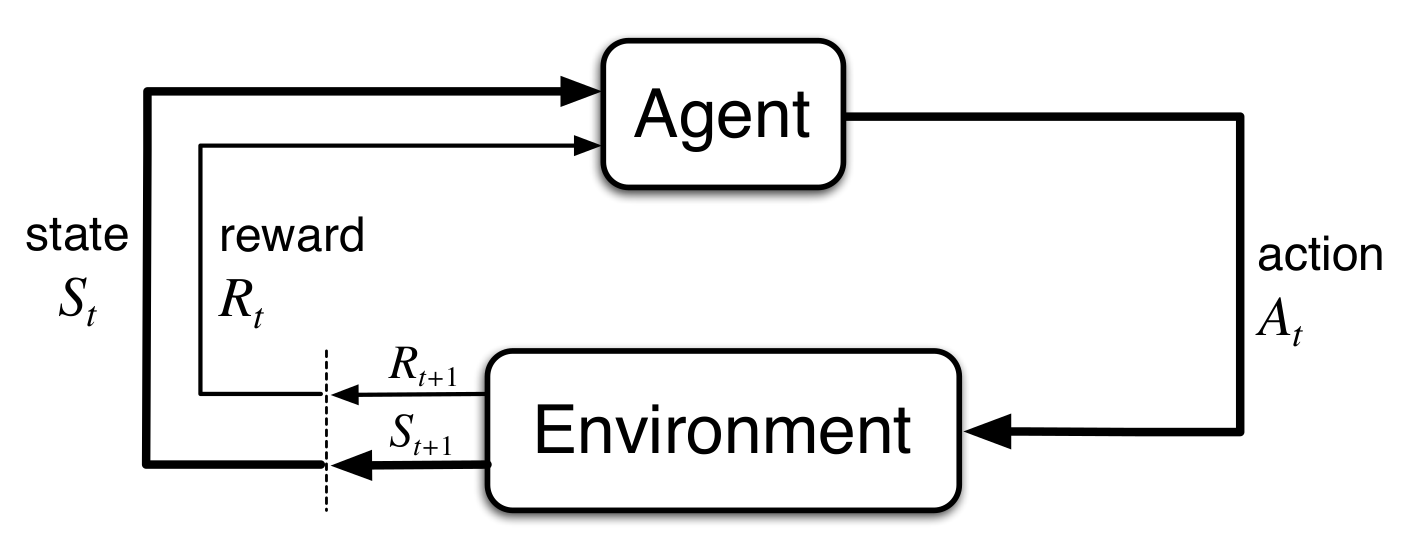
This can be further formalize using the framework of Markov Decision Proceses (MDPs). Using this framework we can define our RL problem as follows:
A Markov Decision Process (MDP) is defined as a tuple of the following components:
- A state space \( \mathbb{S} \) of configurations \( s_{t} \) for an agent.
- An action space \( \mathbb{A} \) of actions \( a_{t} \) that the agent can take in the environment.
- A transition model \( p(s',r | s,a) \) that defines the distribution of states that an agent can land on and rewards it can obtain \( (s',r) \) by taking an action \( a \) in a state \( s \).
The objective of the agent is to maximize the total sum of rewards that it can get from its interactions, and because the environment can potentially be stochastic (recall that the transition model defines a probability distribution) the objective is usually formulated as an expectation ( \( \mathbb{E} \) ) over the random variable defined by the total sum of rewards. Mathematically, this objective is described as follows.
\[ \mathbb{E} \left \{ r_{t+1} + r_{t+2} + r_{t+3} + \dots \right \} \]
Notice the expectation is over the sum of a sequence of rewards. This sequence comes from a trajectory (\( \tau \)) that the agent defines by interacting with the environment in a sequential manner.
\[ \tau = \left \{ (s_{0},a_{0},r_{1}),(s_{1},a_{1},r_{2}),\dots,(s_{t},a_{t},r_{t+1}),\dots \right \} \]
Tasks that always give finite-size trajectories can be defined as episodic, like in games, whereas tasks that go on forever are defined as continuous, like life itself (wait, I'm not elf 😨). The task we are dealing in this post is episodic, and the length of an episode (max. length of any trajectory) is 300 steps.
There is a slight addition to the objective defined earlier that is often used: the discount factor \( \gamma \). This factor tries to take into account the effect that a same ammount of reward in the far future should be less interesting to the agent than the same amount now (kind of like interest rates when dealing with money). We introduce this by multiplying each reward by a power of this factor to the number of steps into the future.
\[ \mathbb{E} \left \{ r_{t+1} + \gamma r_{t+2} + \gamma^{2} r_{t+3} + \dots \right \} \]
Sidenote: The most important reason we use discounting is for mathematical convenience, as it allows to keep our objective from exploding in the non-episodic case (to derive this, just replace each \( r_{t} \) for the maximum reward \( r_{max} \), and sum up the geometric series). There is another approach which deals with the undiscounted average reward setting. This approach leads to a different set of bellman equations from the ones that are normally studied, and therefore different algorithms.
A solution to the RL problem consists of a Policy \( \pi \), which is a mapping from the current state we are ( \( s_{t} \) ) to an appropriate action ( \( a_{t} \) ) from the action space. Such mapping is basically a function, and we can define it as follows:
A deterministic policy is a mapping \( \pi : \mathbb{S} \rightarrow \mathbb{A} \) that returns an action to take \( a_{t} \) from a given state \( s_{t} \).
\[ a_{t} = \pi(s_{t}) \]
We could also define an stochastic policy which, instead of returning an action \( a_{t} \) in a certain situation given by the state \( s_{t} \), it returns a distribution over all possible actions that can be taken in that situation \( a_{t} \sim \pi(.|s_{t}) \).
A stochastic policy is a mapping \( \pi : \mathbb{S} \times \mathbb{A} \rightarrow \mathbb{R} \) that returns a distribution over actions \( a_{t} \) to take from a given state \( s_{t} \).
\[ a_{t} \sim \pi(.|s_{t}) \]
Our objective can then be formulated as follows: find a policy \( \pi \) that maximizes the expected discounted sum of rewards.
\[ \max_{\pi} \mathbb{E}_{\pi} \left \{ r_{t+1} + \gamma r_{t+2} + \gamma^{2} r_{t+3} + \dots \right \} \]
To wrap up this section we will introduce three more concepts that we will use throughout the rest of this post: returns \( G \), state-value functions \( V(s) \) and action-value functions \( Q(s,a) \).
The return \( G_{t} \) is defined as the discounted sum of rewards obtained over a trajectory from time step \( t \) onwards.
\[ G_{t} = r_{t+1} + \gamma r_{t+2} + \gamma^{2} r_{t+3} + \dots = \sum_{k=0}^{\infty} \gamma^{k} r_{t+k+1} \]
By using the return we can write the objective of the agent in a more compact way, as follows:
\[ \max_{\pi} \mathbb{E}_{\pi} \left \{ G_{t} \right \} \]
The state-value function \( V_{\pi}(s) \) is defined as the expected return that an agent can get if it starts at state \( s_{t} = s \) and then follows policy \( \pi \) onwards.
\[ V_{\pi}(s) = \mathbb{E} \left \{ G_{t} | s_{t} = s; \pi \right \} \]
This function \( V_{\pi}(s) \) serves as a kind of intuition of how well a certain state is if we are following a specific policy. The figure below (taken from the DQN paper [2]) illustrates this more clearly with the game of breakout as an example. The agent's state-value function on the bottom part of the figure shows that in the state in which the agent makes a hole in the bricks its estimate of the value greatly increases (section labeled with 4) in the graph.
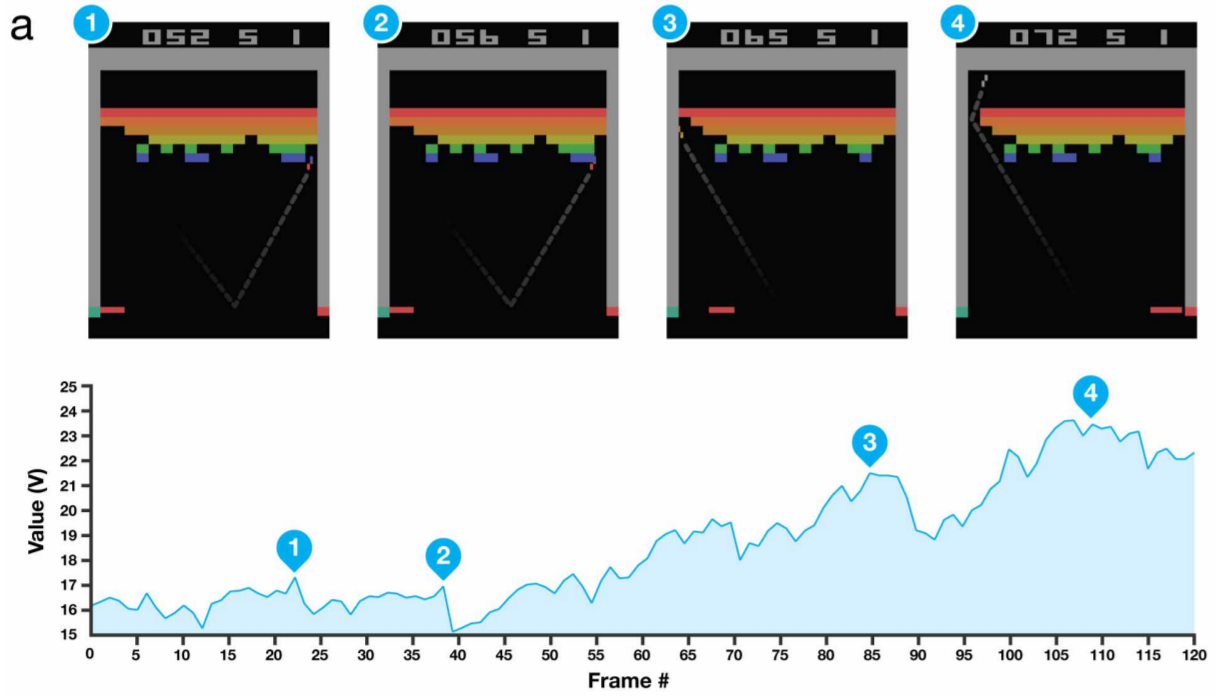
The action-value function \( Q_{\pi}(s,a) \) is defined as the expected return that an agent can get if it starts at state \( s_{t} = s \), takes an action \( a_{t} = a \) and then follows the policy \( \pi \) onwards.
\[ Q_{\pi}(s,a) = \mathbb{E} \left \{ G_{t} | s_{t} = s, a_{t} = a; \pi \right \} \]
This function \( Q_{\pi}(s,a) \) serves also as a kind of intuition of how well a certain action is if we apply it in a certation state if we are following a specific policy. The figure below illustrates this more clearly (again, taken from the DQN paper [2]) with the game of pong as an example. The agent's action-value function tell us how well is a certain action in a certain situation, and as you can see in the states labeled with (2) and (3) the function estimates that action UP will give a greater return than the other two actions.
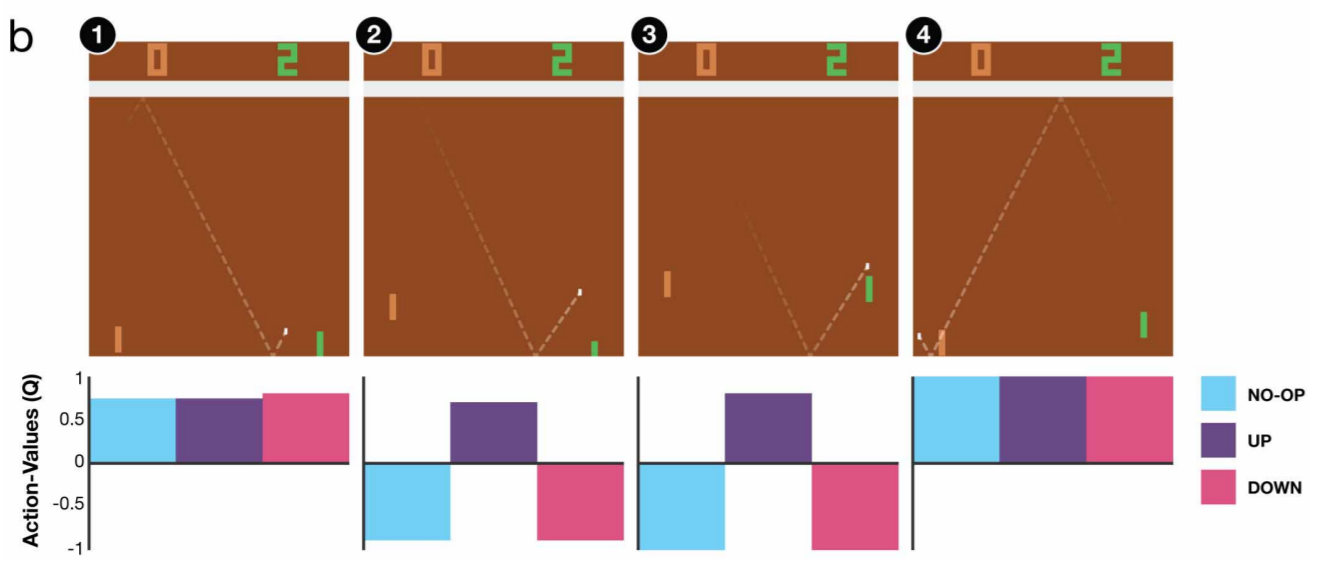
3.2 RL solution methods
There are various methods that we can use to solve this problem. The figure below (from [3]) shows a taxonomy of the available approaches and methods within each approach. We will be following the Value-based approach, in which we will try to obtain the optimal action-value function \( Q^{\star} \).
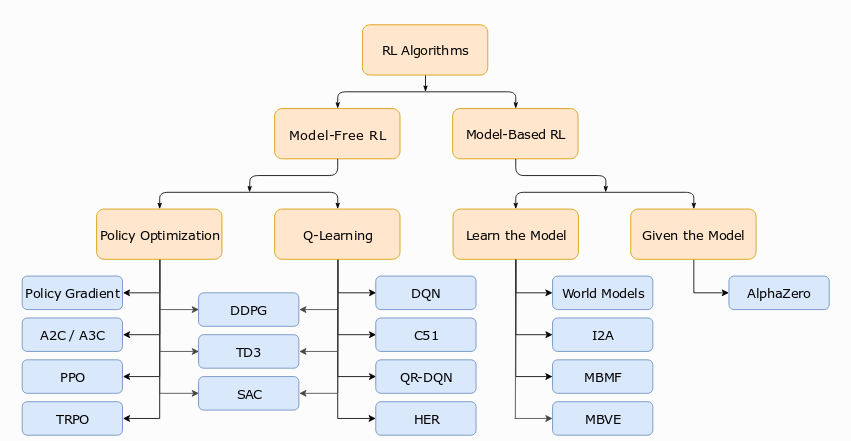
Value based methods are based on the Bellman Equations, which specify what the optimal state-value and action-value functions should satisfy in order to be optimal. Below we show the Bellman Optimality Equation for \( Q^{\star} \), and the solution \( Q^{\star} \) of this equation is a fixed point that can be computed exactly using Dynamic Drogramming (if a model of the environment is known) or approximately with Monte Carlo and Temporal Difference methods (if no model of the environment is available).
\[ Q^{\star}(s,a) = \mathbb{E}_{(s,a,s',r)} \left \{ r + \gamma \max_{a'} Q^{\star}(s',a') \right \} \]
3.3 Tabular Q-learning
The method we will use is called Q-learning, which is a model-free method that recovers \( Q^{\star} \) from experiences using the following update rule:
\[ Q(s,a) := \overbrace{Q(s,a)}^{\text{Current estimate}} + \alpha ( \overbrace{r + \gamma \max_{a'} Q(s',a')}^{\text{"Better" estimate}} - Q(s,a) ) \]
This update rule is used in the tabular case, which is used when dealing with discrete state and action spaces. These cases allow to easily represent the action-value function in a table (numpy array or dictionary), and update each entry of this table separately.
For example, consider a simple MDP with \( \mathbb{S}=0,1\) and \( \mathbb{A}=0,1\). The action-value function could be represented with the following table.
| State (s) | Action (a) | Q-value Q(s,a) |
|---|---|---|
| 0 | 0 | Q(0,0) |
| 0 | 1 | Q(0,1) |
| 1 | 0 | Q(1,0) |
| 1 | 1 | Q(1,1) |
In python we could just use :
# define a Q-table initialized with zeros (using numpy)
import numpy as np
Q = np.zeros( (nStates, nActions), dtype = np.float32 )
# define a Q-table initialized with zeros (using dictionaries)
from collections import defaultdict
Q = defaultdict( lambda : np.zeros( nActions ) )
The Q-learning algorithm for the tabular case is shown below, and it basically consists of updating the estimate of the q-value \( Q(s,a) \) for the state-action pair \( (s,a) \) from another estimate of the true q-value of the optimal policy given by \( r + \gamma \max_{a'} Q(s',a') \) called the TD-Target.
Q-learning (off-policy TD control)
- Algorithm parameters: step size \( \alpha \in [0,1] \), small \( \epsilon \gt 0 \)
Initialize q-table \( Q(s,a) \) for all \( s \in \mathbb{S}, a \in \mathbb{A} \)
For each episode:
- Sample initial state \( s_{0} \) from the starting distribution.
- For each step \( t \) in the episode :
- Select \( a_{t} \) from \( s_{t} \) using e-greedy from \( Q \)
- Execute action \( a_{t} \) in the environment, and receive reward \( r_{t+1} \) and next state \( s_{t+1} \)
- Update entry in q-table corresponding to \( (s,a) \):
\[ Q(s,a) := Q(s,a) + \alpha ( r + \gamma \max_{a'} Q(s',a') - Q(s,a) ) \]
In python we would have the following :
def qlearning( env, Q, eps, alpha, gamma, numEpisodes, maxStepsPerEpisode ) :
"""Run q-learning to estimate the optimal Q* for the given environment
Args:
env : environment to be solved
Q : action value function represented as a table
eps : epsilon value for e-greedy heuristic (exploration)
alpha : learning rate
gamma : discount factor
numEpisodes : number of episodes to run the algorithm
maxStepsPerEpisode : maximum number of steps in an episode
"""
for iepisode in range( numEpisodes ) :
# sample initial state from the starting distribution (given by env. impl.)
_s = env.reset()
for istep in range( maxStepsPerEpisode ) :
# select action using e-greedy policy
_a = np.random.randint( env.nA ) if np.random.random() < eps else np.argmax( Q[_s] )
# execute action in the environment and receive reward and next state
_snext, _r, _finished, _ = env.step( _a )
# compute target to update
if _finished :
_tdTarget = _r
else :
_tdTarget = _r + gamma * np.max( Q[_snext] )
# update entry for (_s,_a) using q-learning update rule
Q[_s][_a] = Q[_s][_a] + alpha * ( _tdTarget - Q[_s][_a] )
# cache info for next step
_s = _snext
For further information about Q-learning you can check the resources from [4,5,6]
3.4 Function approximation
The tabular case provides a nice way to solve our problem, but at the cost of storing a big table with one entry per possible \( (s,a) \) pair. This is not scalable to larger state spaces, which is the case for continous spaces. One approach would be to discretize the state space into bins for various \( (s,a) \), treat each bin as an entry for the table and then solve as in the tabular case. However this is not practical for various reasons :
- As the discretization gets more precise we end up with more bins and our table explodes in size. This is an exponential explosion due to the curse of dimensionality.
- Each possible \( (s,a) \) is stored separately and updated separately, which doesn't take into account the fact that nearby \( (s,a) \) pairs should have similar \( Q(s,a) \) values. This means we are not generalizing our knowledge of one pair to nearby pairs.
To solve these issues we make use of function approximators like linear models, radial basis functions, neural networks, etc., which allow us to scale up to high dimensional spaces and "generalize" over these spaces.
Building on top of the previous Q-learning algorithm, we can write an algorithm to obtain the action-value function using function approximation. In this case we parametrize our action-value function as \( Q_{\theta}(s,a) \) where \( \theta \) are the parameters of the function approximator, e.g. the weights of a neural network. Recall from tabular Q-learning that the update rule tried to improve an estimate of a q-value \( Q(s,a) \) from another estimate \( r + \gamma \max_{a'} Q(s',a') \) which we called TD-target. This was necessary as we did not have a true value for the q-value at \( (s,a) \), so we had to use a guess.
Suppose we have access to the actual q-value for all \( (s,a) \) possible pairs. We could then use this true q-value and make our estimates become these true q-values. In the tabular case we could just replace these for each entry, and for the function approximation case we make something similar: What do we do if we have the true values (or labels) that our model has to give for some inputs?. Well, we just fit our model to the data like in supervised learning.
\[ \theta = \argmin_{\theta} \mathbb{E}_{(s,a) \sim D} \left \{ ( Q^{\star}(s,a) - Q_{\theta}(s,a) )^{2} \right \} \]
If our function approximator is differentiable we then could just use Gradient Descent to obtain the parameters \( \theta \) of our model:
\[ \theta := \theta - \frac{1}{2} \alpha \nabla_{\theta} \mathbb{E}_{(s,a) \sim D} \left \{ ( Q^{\star}(s,a) - Q_{\theta}(s,a) )^{2} \right \} \\ \rightarrow \theta := \theta - \frac{1}{2} \alpha \mathbb{E}_{(s,a) \sim D} \left \{ \nabla_{\theta}( Q^{\star}(s,a) - Q_{\theta}(s,a) )^{2} \right \} \\ \rightarrow \theta := \theta + \alpha \mathbb{E}_{(s,a) \sim D} \left \{ (Q^{\star}(s,a) - Q_{\theta}(s,a)) \nabla_{\theta}Q_{\theta}\vert_{(s,a)} \right \} \\ \]
Or, if using Stochastic Gradient Descent (SGD) :
\[ \theta := \theta + \alpha (Q^{\star}(s,a) - Q_{\theta}(s,a)) \nabla_{\theta}Q_{\theta}\vert_{(s,a)} \]
Unfortunately, we do not have an oracle that would tell us the true q-values for each possible \( (s,a) \) pair. Here we use a similar approach to tabular Q-learning, namely use an estimate of the true q-value to update our current estimate. This estimate of the true q-value was our TD-target, so we could just replace it in the SGD update rule derived before:
\[ \theta := \theta + \alpha (r + \gamma \max_{a'}Q_{\theta}(s',a') - Q_{\theta}(s,a)) \nabla_{\theta}Q_{\theta}\vert_{(s,a)} \]
This yields the following algorithm:
Action-Value function approximation
- Parameters: learning rate \( \alpha \in [0,1] \), small \( \epsilon \gt 0 \)
Initialize a parametrized action-value function \( Q_{\theta} \)
For each episode:
- Sample initial state \( s_{0} \) from the starting distribution
- For each step \( t \) in the episode :
- Select \( a_{t} \) from \( s_{t} \) using e-greedy from \( Q_{\theta} \)
- Execute action \( a_{t} \) in the environment, and receive reward \( r_{t+1} \) and next state \( s_{t+1} \)
- If \( s' \) is terminal:
- \( Q_{target} = r \)
- Else:
- \( Q_{target} = r + \gamma \max_{a'}Q_{\theta}(s',a') \)
- Update parameters \( \theta \) using the following update rule :
\[ \theta := \theta + \alpha ( Q_{target} - Q_{\theta}(s_{t},a_{t}) ) \nabla_{\theta} Q_{\theta}\vert_{s=s_{t},a=a_{t}} \]
This algorithm forms the basis of the DQN agent, which adds various improvements on top of this base algorithm. These improvements help to stabilize learning as there are various issues when using the Vanilla version of this algorithm directly with a Deep Neural Network as a function approximator.
3.5 Deep Q-Learning
At last, this section will describe the Deep Q-Learning algorithm, which builds on top of the algorithm previously described.
3.5.1 End-to-end learning
A key issue we did not discussed in the previous section was how we used these function approximators, which is actually a similar story to the previous techniques used in Computer Vision before Deep Learning came back to life.
Usually when using a function approximator the inputs to this model are not direct raw sensory data, but some intermediate representation in the form of features. These features had to be carefully engineered for the specific task at hand (like in the case of Computer Vision). Fortunately, we can use Deep Learning to help us come with the right internal features required for the problem we are trying to solve, as shown in the image below.

Similarly, we can combine Deep Learning (as powerful function approximators) with Reinforcement Learning into a similar pipeline that would allow the agent learn the required representations to solve the task at hand.

However, unlike supervised learning, the RL setup forces us to deal with sequential data, which breaks the i.i.d. assumption (independent and identically distributed). This brings correlations in the data that break direct vanilla approaches (just replacing the function approximator with a deep network, and hoping for the best). Moreover, unlike the tabular setup, there are no convergence guarantees for our algorithms when using non-linear function approximators (see Chapter 11 in [1] for further info).
To solve part of these issues, the authors in [2] developed various improvements to the Vanilla setting that helped stabilize learning and break these annoying correlations: Experience Replay and Fixed Targets.
3.5.2 DQN: Experience Replay
Experience replay is a mechanism introduced in [2] and it consists of Learning from past stored experiences during replay sessions. Basically, we remember our experiences in memory (called a replay buffer) and learn from them later. This allows us to make more efficient use of past experiences by not throwing away samples right away, and it also helps to break one type of correlations: sequential correlations between experiences \( (s_{t},a_{t},r_{t+1},s_{t+1}) \). In Figure 11 we try to depict this type of correlation by showing 3 consecutive experience tuples along a trajectory. Assuming we are doing one gradient update with each tuple using SGD we are then pushing our learned weights according to the reward obtained (recall the td-target is used as a true estimate for our algorithm). So, we are effectively pushing our weights using each sample, which in turn depended on the previous one (both reward and next state) because of the same process happening a time step before (the weights were pushed a bit using previous rewards).
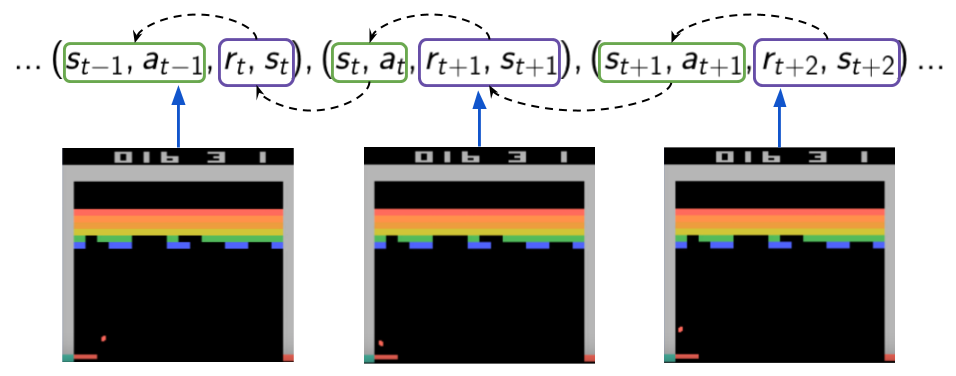
We'll borrow the example from the Udacity Nanodegree [8] to explain this issue a bit further: Suppose you are learning to play tennis and you are using the action-value function approximation algorithm from last section to learn from your tennis training experiences whether to use your forehand or backhand shots in specific situations. Recall that, unlike the tabular case, nearby pairs in state-action space will have similar values (which is actually what we wanted when discussing "generalization"). In the case of our tennis example, if we learn online as we practice we might start getting a situation that favors using our forehand shot (because we might have started getting more chances to use our forehand), which might be good for balls coming from the right. However, due to our function approximator, our Q-function will start to favor ever so slightly the forehand action even in cases were the ball comes to our left. I placed a question mark for the q-values of the other action as we might not know how their values are evolving as we update only the other action. If we have a single model for our \( Q_{\theta} \), as we change the weights of our network we will also slightly alter the values for other actions in potentially undesired ways.
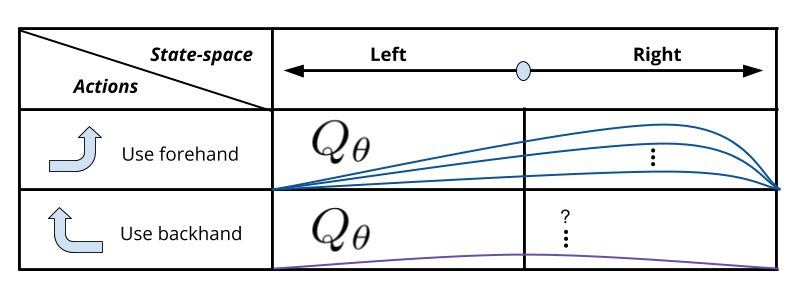
To solve these issues, the Experience Replay mechanism makes the agent learn from minibatches of past stored experience during training steps. We basically put all our experience in memory and then sample uniformly at random from it, which helps break the correlations between samples in the minibatch as they might not come from consequent steps (or even come from different episodes). This is depicted in Figure 13 below.
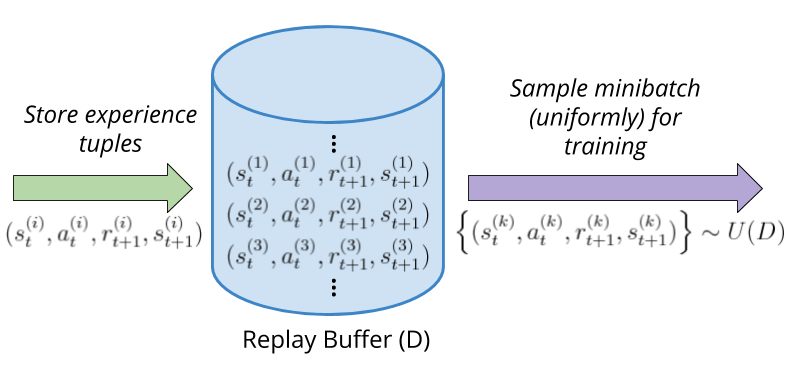
3.5.3 DQN: Fixed Targets
During training we are using the TD-target as the estimate of the true q-values that our Q-network should output for a specific pair \( (s,a) \) (as shown in the equation below). Unfortunately, this estimate is being computed using the current parameters of the Q-network which effectively is forcing us to follow a moving target. Besides, this is not mathematically correct, as we assumed these "true q-values" were not dependent on \( \theta \) (recall we did not take the gradient of this term).
\[ \theta := \theta + \alpha ( \overbrace{r + \max_{a'}Q(s',a';\theta)}^{\text{Computed with $\theta$}} - Q(s,a;\theta) ) \overbrace{\nabla_{\theta}Q_{\theta}\vert_{(s,a)}}^{\text{Computed with $\theta$}} \]
To help training stability the authors of [2] introduced the use of a separate network to compute these targets called a Target Network, which is almost the same as the network used for taking actions. The key difference is that the weights of this network are only copied from the weights of the other network after some specific number of steps. Therefore, the update rule can be modified as follows :
\[ \theta := \theta + \alpha ( \overbrace{r + \max_{a'}\underbrace{Q(s',a';\theta^{-})}_{\text{Target-network}}}^{\text{Computed with $\theta^{-}$}} - Q(s,a;\theta) ) \overbrace{\nabla_{\theta}Q_{\theta}\vert_{(s,a)}}^{\text{Computed with $\theta$}} \]
A slight variation to this update at constant intervals is to do updates every time step using interpolations, as shown in the following equation :
\[ \theta^{-} := (1 - \tau) \theta^{-} + \tau \theta \]
This are called soft-updates, and by adjusting the factor \( \tau \) (to some small values) we get a similar effect of copying the weights of the networks after a fixed number of steps. The difference is that, as the name suggests, these updates are less jumpy than the hard-updates made by copying entirely the weights of the network. At convergence, this update is very similar to a hard-update as the network weights do not change too much.
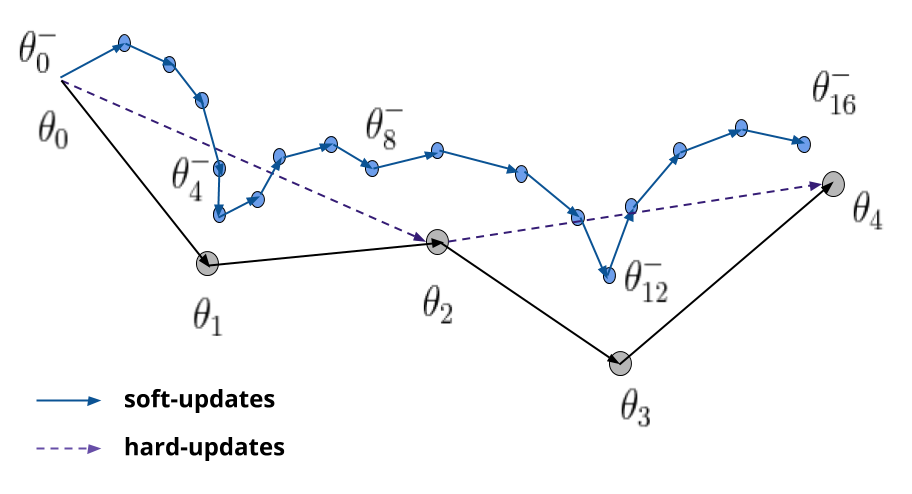
3.5.4 Sidenote: on the intuition behind issues with correlations
A way I like to use to reason about these issues related to correlations is by looking at the loss function we want to optimize (shown below). As you can see, we are computing a Mean-Square loss which computes the expectation over samples of the square differences between targets and current estimates.
\[ L({\theta}) = \mathbb{E}_{(s,a,r,s') \sim D} \left \{ ( r + \gamma \max_{a'} Q_{\theta}(s',a') - Q_{\theta}(s,a) )^{2} \right \} \]
As you can see, if our inputs (experience tuples) are correlated (breaking the i.i.d. assumption) we will not be able to compute this expectation from samples (can't apply the law of large numbers nor use a monte carlo estimate). Moreover, if trying to convert our RL problem into a supervised setting we will run into the issue that the target estimates (labels) should be decoupled from the estimates of our model. If not, we can run in instabilities by following a moving target, kind of like following our own opinions as universal truth, even when they might not be correct. Even more, if we start having strong opinions about a topic and use this to infer even more knowledge that reinforces these opinions, we will then fall into a vicious cycle of unstable learning. If that is the case in life, keep an open mind, recall good and bad experiences and don't forget to live with a little bit of \( \epsilon \) here and there 😉.
3.5.4 DQN: Putting it all together
Finally, by integrating all the previous improvements (Experience replay and Fixed targets) we get the complete version of the DQN algorithm from [2]. Below we show a modified version of the algorithm from [2] that uses soft-udpates instead of regular updates.
Deep-Q Learning with Experience Replay and Soft updates
- Initialize action-value function \( Q \) with parameters \( \theta \)
- Initialize target action-value function \( \hat Q \) with parameters \( \theta^{-} = \theta \)
Initialize replay memory \( D \) to a certain capacity
For \(episode = 0,1,2, \dots \)
- Sample initial state \( s_{0} \) from the starting distribution
- Preprocess: \( \phi_{0} = \phi( s_{0} ) \)
- For \( t = 0,1,2, \dots \)
- Select \( a_{t} \) from \( \phi_{t} \) using e-greedy from \( Q_{\theta} \)
- Execute action \( a_{t} \) in the environment, and receive reward \( r_{t+1} \) and next state \( s_{t+1} \)
- Preprocess: \( \phi_{t+1} = \phi( s_{t+1} ) \)
- Store transition in replay buffer: \( (\phi_{t},a_{t},r_{t+1},\phi_{t+1}) \rightarrow D \)
- Every \( T \) steps (training session):
- Sample a minibatch \(\left \{ (\phi_{j}, a_{j}, r_{j+1}, \phi_{j+1}) \right \} \sim D \)
- Set Q-targets: \(\\ y_{j} = \begin{cases} r_{j+1} &\text{if } \phi_{j+1} \text{ is terminal} \\ r_{j+1} + \gamma \max_{a'} \hat Q(\phi_{j+1},a';\theta^{-}) &\text{otherwise} \end{cases}\)
- Update the action-value network parameters \( \theta \) by taking a step of SGD on \( (y_{j} - Q(\phi_{j},a_{j};\theta))^{2} \)
- Update the target action-value network parameters \( \theta^{-} \) using soft updates: \(\\ \theta^{-} = (1-\alpha)\theta^{-} + \alpha \theta \)
- Anneal \( \epsilon \) using a specified schedule
Below are some key aspects to take into consideration:
Preprocessing \( \phi_{t} = \phi( s_{t} ) \):
This step consists in converting the states|observations \( s_{t} \) received from the simulator into an appropriate state representation that can be used by our action-value network \( Q(\phi_{t},a_{t};\theta) \). We usually receive observations from the environment which in some cases (if we are lucky) consist of the actual internal state representation of the world. Unfortunately, in most cases we only receive observations that do not permit to fully recover the internal state of the environment. To avoid this issue we can design a state representation from these observations that would push us a bit more into the MDP setting and not the POMDP setting (Partially Observable MDP). In [2] the authors designed a state representation from the raw frame observations from the simulator by stacking a group of 4 consecutive frames, which tries to help encode a bit of temporal information (like speed and movement in the scene). This step is problem specific, and in our Banana collector case we chose to use the direct observations as state representation, although we could have made modifications to add more temporal information which could help with the problem of state aliasing. For further information on this topic you can watch part of this lecture from [7].
Grounding terminal estimates :
Grounding the estimates for terminal states is important because we don't want to make an estimate to the value for a terminal state bigger than what it could actually be. If we are just one step away of a terminal state, then our trajectories have length one and the return we obtain is actually only that reward. All previous algorithms do a check of whether or not a state is terminal in order to compute the appropriate TD-target. However, in tabular Q-learning you will find that in some implementations (unlike the one we presented earlier) there is no check similar to this one, but instead the entries of the Q-table are set to zeros for the terminal states, which is effectively the same as doing this check, as shown in the equation below:
\[ TD_{target} = r + \gamma \max_{a'}Q(s_{terminal}^{'},a') = r + \gamma max_{a'}0_{\vert \mathbb{A} \vert} = r \]
Unfortunaly, because we are dealing with function approximation, the estimates for a terminal states if evaluated will not return always zero, even if we initialize the function approximator to output zeros everywhere (like initializing the weights of a neural network to all zeros). This is caused by the fact that changes in the approximator parameters will affect the values of nearby states-action pairs in state-action space as well even in the slightest. For further information, you could check this lecture by Volodymyr Mnih from [9]. So, keep this in mind when implementing your own version of DQN, as you might run into subtle bugs in your implementations.
Exploration schedule :
Another important detail to keep in mind is the amount of exploration allowed by our \( \epsilon \)-greedy mechanism, and how we reduce it as learning progresses. This aspect is not only important in this context of function approximation, but in general as it's a key tradeoff to take into account (exploration v.s. exploitation dilemma). They idea is to give the agent a big enough number of steps to explore and get experiences that actually land some diverse good and bad returns, and then start reducing this ammount of exploration as learning progresses towards convergence. The mechanism used in [2] is to linearly decay \( \epsilon = 1.0 \rightarrow 0.1 \). Another method would be to decay it exponentially by multiplying \( \epsilon \) with a constant decay factor every episode. For further information you could check this lecture by David Silver from [6].
Choice for \( Q_{\theta}(s,a) \)
The last detail is related to the actual choice we make how to model our Q-network. We have two choices: either treat both inputs \( s,a \) as a single input \( (s,a) \) to the network, which would allows us to compute one q-value for a given state-action pair, or use \( s \) as only input to the network and grab all the q-values for all actions \( a \in \mathbb{A} \). Both of these options are shown in the figure below.
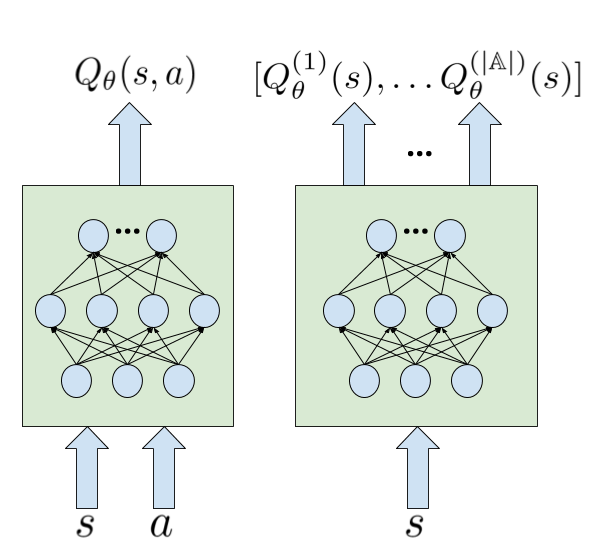
The first option would cost more as we need to compute all q-values in order to grab the maximum of them for both the TD-target calculation and the \( \epsilon \)-greedy action selection. The second option was the one used in [2], and it's the one will use for our implementation.
Sidenote : I couldn't help but notice that the cost function would change a bit due to our choice. Recall the loss function we defined for action-value function approximation:
\[ L(\theta) = \mathbb{E}_{s,a} \left \{ ( Q^{\star}(s,a) - \hat Q_{\theta}(s,a) )^{2} \right \} \]
If we use the network we chose before we would have to change the term \(\hat Q_{\theta}(s,a)\) by the term \(\hat Q_{\theta}^{(a)}(s)\) (or equivalently \(e_{a}^{T} \hat Q_{\theta}(s)\) if you prefer dot products). Thus, our loss function would change to:
\[ L(\theta) = \mathbb{E}_{s,a} \left \{ ( Q^{\star}(s,a) - \hat Q_{\theta}^{(a)}(s) )^{2} \right \} \]
Now, if we compute the gradient of this objective w.r.t. \( \theta \), after some operations (like in the function approximation derivation from earlier) we would get the following:
\[ \nabla_{\theta}L = \mathbb{E}_{s,a} \left \{ 2 ( Q^{\star}(s,a) - \hat Q_{\theta}^{(a)}(s) ) \nabla_{\theta} \hat Q_{\theta}^{(a)}(s) \right \} \]
Or, if using the dot product instead of indexing:
\[ \nabla_{\theta}L = \mathbb{E}_{s,a} \left \{ 2 ( Q^{\star}(s,a) - e_{a}^{T}\hat Q_{\theta}(s) ) \nabla_{\theta} (e_{a}^{T}\hat Q_{\theta}(s)) \right \} \]
If you expand the later (the gradient of the dot product) you can actually take that constant vector out, and then we would end up with the Jacobian of \( \hat Q_{\theta}(s) \). Both are at the end equivalent if you do the algebra, but I wonder how these are implemented by the autodiff. The funny thing is that this was a kind of hidden detail from most resources I found online. So, at first it looks like a linear regression problem (and that's how it should be if we had used the first option for the network instead), but instead it's like a multi-dimensional regression problem but with masks over some dimensions. Hopefully, autodiff handles this subtleties for us 😄. I'll update this part once I have some more time to get into the inner workings of the autodiff (so far, I was checking the torch's derivatives.yaml file where the gradient definitions are and it seems that the one doing the job might be the index_select_backward function when used by the kthvalue function, or the function index_select, or the function gather).
4. DQN Implementation
At last, in this section we will cover the full implementation of the DQN algorithm from [2] that uses soft-updates. This implementation is based on the original DQN implementation from Deepmind (written in Torch and Lua), which can be found here. Our implementation tries to decouple the key aspects of the algorithm from the model itself in a kind of library-agnostic way (effectively decoupling the RL part from the DL part). At the end of this section we will add some considerations we made for our implementation.
Disclaimer: the trained model has not been tested in the Bnana-Visual environment, which provides as observations frames instead of the vector observations discussed earlier. There might be some code that is related to the visual case which I've been testing for a while, but I'm still debugging it. I'll update this post with the visual case as well once I have it working properly.
4.1 Interfaces and Concretions
Our implementation makes use of abstractions and decoupling, as we implemented the algorithm from scratch. The main reason is that we wanted to grasp extra details of the algorithm without following another implementation step by step (and also to avoid having a pile of tf.ops to deal with or some pytorch specific functionality laying around the core features of the algorithm 😄).
Just to be in the same page, by an Interface we mean a class that provides a blueprint for other classes to extend. These interfaces could have declarations of methods and data that their objects will use, but it does not implement them (at least most of them) and leaves some pure-virtual methods to be implemented by a child class. A Concretion is a specific class that extends the functionality of this interface, and it has to implement the pure-virtual methods. For example, our agent interface defines the functionality that is exposed by any agent along with some code that all concretions should have (like the actual steps of the DQN algorithm) but leaves some methods for the concrete agents, like the preprocess method which is case specific; and an agent concretion could be an agent that extends this functionality (and gains the common DQN implementation) but implements its own version of the preprocess step.
The interfaces and some of its concretions are listed below:
- Agent Interface, along concrete agents for BananaSimple, BananaVisual and Gridworld.
- Model Interface, along concrete models for Pytorch, Tensorflow or a numpy q-table.
- Memory Interface, along concrete buffers like ReplayBuffer and PriorityBuffer.
We wanted to make these interfaces as decoupled as possible from any Deep Learning package, which allowed us to test each component separately (we did not want to get into subtle bugs and poor performance due to specifics of the DL package). We specially made use of this feature when testing the core agent interface with a simple gridworld environment. This allowed us to find some bugs in our inplementation of the steps in the DQN algorithm that might have taken us more time if considering also the possibility that our DL model was buggy.
4.2 Agent Interface and Concretions
This interface has the implementation of the steps in the DQN algorithm, and has as components the model and memory in order to query them as needed. This is an "Abstract Class" in the sense that it shouldn't be instantiated. Instead, a specific class that inherits from this interface has to implement the preprocess method. Below we show this interface (only the methods, to give a sense of how this interface works), which can be found in the agent.py file in the dqn/core folder of the navigation package.
The key methods to be considered are the __init__, act, step, _preprocess and _learn methods, which implement most of the required steps of the DQN algorithm. We will discuss some of their details in snippets below, and we encourage the reader to look at the full implementation using the hyperlinks provided. Some might have some details removed (like dev. changes during testing), so they might look a bit different than the originals from the repo.
class IDqnAgent( object ) :
def __init__( self, agentConfig, modelConfig, modelBuilder, backendInitializer ) :
"""Constructs a generic Dqn agent, given configuration information
Args:
agentConfig (DqnAgentConfig) : config object with agent parameters
modelConfig (DqnModelConfig) : config object with model parameters
modelBuilder (function) : factory function to instantiate the model
backendInitializer (function) : function to be called to intialize specifics of each DL library
"""
###############################################
## IMPLEMENTATION HERE
###############################################
def save( self, filename ) :
"""Saves learned models into disk
Args:
filename (str) : filepath where we want to save the our model
"""
###############################################
## IMPLEMENTATION HERE
###############################################
def load( self, filename ) :
"""Loads a trained model from disk
Args:
filename (str) : filepath where we want to load our model from
"""
###############################################
## IMPLEMENTATION HERE
###############################################
def act( self, state, inference = False ) :
"""Returns an action to take from the given state
Args:
state (object) : state|observation coming from the simulator
inference (bool) : whether or not we are in inference mode
Returns:
int : action to take (assuming discrete actions space)
"""
###############################################
## IMPLEMENTATION HERE
###############################################
def step( self, transition ) :
"""Does one step of the learning algorithm, from Mnih et. al.
https://storage.googleapis.com/deepmind-media/dqn/DQNNaturePaper.pdf
"""
###############################################
## IMPLEMENTATION HERE
###############################################
def _preprocess( self, rawState ) :
"""Preprocess a raw state into an appropriate state representation
Args:
rawState (np.ndarray) : raw state to be transformed
Returns:
np.ndarray : preprocess state into the approrpiate representation
"""
raise NotImplementedError( 'IDqnAgent::_preprocess> virtual method' )
def _learn( self ) :
"""Makes a learning step using the DQN algorithm from Mnih et. al.
https://storage.googleapis.com/deepmind-media/dqn/DQNNaturePaper.pdf
"""
###############################################
## IMPLEMENTATION HERE
###############################################
@property
def epsilon( self ) :
return self._epsilon
@property
def seed( self ) :
return self._seed
@property
def learningMaxSteps( self ) :
return self._learningMaxSteps
@property
def actorModel( self ) :
return self._qmodel_actor
@property
def targetModel( self ) :
return self._qmodel_target
@property
def replayBuffer( self ) :
return self._rbuffer
- First we have the __init__ method, whose implementation is shown briefly in the snippet below. This is the constructor of our agent and is in charge of copying the hyperparameters from the passed configuration objects, create the models (action-value and target action-value networks), create the replay buffer (or a priority-based replay buffer if requested) and some other initialization stuff. We get around having to decouple the specific model creation code by passing a factory method that takes care of this.
def __init__( self, agentConfig, modelConfig, modelBuilder, backendInitializer ) :
"""Constructs a generic Dqn agent, given configuration information
Args:
agentConfig (DqnAgentConfig) : config object with agent parameters
modelConfig (DqnModelConfig) : config object with model parameters
modelBuilder (function) : factory function to instantiate the model
backendInitializer (function) : function to be called to intialize specifics of each DL library
"""
##################################
## COPY HYPERPARAMETERS ##
##################################
# seed numpy's random number generator
np.random.seed( self._seed )
# create the model accordingly
self._qmodel_actor = modelBuilder( 'actor_model', modelConfig, True )
self._qmodel_target = modelBuilder( 'target_model', modelConfig, False )
##################################
## INITIALIZE MODELS ##
##################################
# start the target model from the actor model
self._qmodel_target.clone( self._qmodel_actor, tau = 1.0 )
# create the replay buffer
if self._usePrioritizedExpReplay :
self._rbuffer = prioritybuffer.PriorityBuffer( self._replayBufferSize,
self._seed )
else :
self._rbuffer = replaybuffer.DqnReplayBuffer( self._replayBufferSize,
self._seed )
- The act method is in charge of deciding which action to take in a given state. This takes care of both the case of doing \( \epsilon \)-greedy during training, and taking only the greedy action during inference. Note that in order to take the greedy actions we query the action-value network with the appropriate state representation in order to get the Q-values required to apply the \( \argmax \) function
def act( self, state, inference = False ) :
"""Returns an action to take from the given state
Args:
state (object) : state|observation coming from the simulator
inference (bool) : whether or not we are in inference mode
Returns:
int : action to take (assuming discrete actions space)
"""
if inference or np.random.rand() > self._epsilon :
return np.argmax( self._qmodel_actor.eval( self._preprocess( state ) ) )
else :
return np.random.choice( self._nActions )
- The step method implements most of the control flow of the DQN algorithm like adding experience tuples to the replay buffer, doing training every few steps (given by a frequency hyperparameter), doing copies of weights (or soft-updates) to the target network every few steps, doing some book keeping of the states, and applying the schedule to \( \epsilon \) to control the ammount of exploration.
def step( self, transition ) :
"""Does one step of the learning algorithm, from Mnih et. al.
https://storage.googleapis.com/deepmind-media/dqn/DQNNaturePaper.pdf
"""
# grab information from this transition
_s, _a, _snext, _r, _done = transition
# preprocess the raw state
self._nextState = self._preprocess( _snext )
if self._currState is None :
self._currState = self._preprocess( _s ) # for first step
# store in replay buffer
self._rbuffer.add( self._currState, _a, self._nextState, _r, _done )
# check if can do a training step
if self._istep > self._learningStartsAt and \
self._istep % self._learningUpdateFreq == 0 and \
len( self._rbuffer ) >= self._minibatchSize :
self._learn()
# update the parameters of the target model (every update_target steps)
if self._istep > self._learningStartsAt and \
self._istep % self._learningUpdateTargetFreq == 0 :
self._qmodel_target.clone( self._qmodel_actor, tau = self._tau )
# save next state (where we currently are in the environment) as current
self._currState = self._nextState
# update the agent's step counter
self._istep += 1
# and the episode counter if we finished an episode, and ...
# the states as well (I had a bug here, becasue I didn't ...
# reset the states).
if _done :
self._iepisode += 1
self._currState = None
self._nextState = None
# check epsilon update schedule and update accordingly
if self._epsSchedule == 'linear' :
# update epsilon using linear schedule
_epsFactor = 1. - ( max( 0, self._istep - self._learningStartsAt ) / self._epsSteps )
_epsDelta = max( 0, ( self._epsStart - self._epsEnd ) * _epsFactor )
self._epsilon = self._epsEnd + _epsDelta
elif self._epsSchedule == 'geometric' :
if _done :
# update epsilon with a geometric decay given by a decay factor
_epsFactor = self._epsDecay if self._istep >= self._learningStartsAt else 1.0
self._epsilon = max( self._epsEnd, self._epsilon * _epsFactor )
- The _preprocess (as mentioned earlier) is a virtual method that has to be implemented by the actual concretions. It receives the observations from the simulator and returns the appropriate state representation to use. Some sample implementations for the BananaSimple-agent, BananaVisual-agent and Gridworld-agent are shown in the snippets that follow.
def _preprocess( self, rawState ) :
"""Preprocess a raw state into an appropriate state representation
Args:
rawState (np.ndarray) : raw state to be transformed
Returns:
np.ndarray : preprocess state into the approrpiate representation
"""
""" OVERRIDE this method with your specific preprocessing """
raise NotImplementedError( 'IDqnAgent::_preprocess> virtual method' )
###############################################
## Simple (just copy) preprocessing ##
###############################################
def _preprocess( self, rawState ) :
# rawState is a vector-observation, so just copy it
return rawState.copy()
###############################################
## One-hot encoding preprocessing ##
###############################################
def _preprocess( self, rawState ) :
# rawState is an index, so convert it to a one-hot representation
_stateOneHot = np.zeros( self._stateDim )
_stateOneHot[rawState] = 1.0
return _stateOneHot
################################################
## Stack 4 frames into vol. preprocessing ##
################################################
def _preprocess( self, rawState ) :
# if queue is empty, just repeat this rawState -------------------------
if len( self._frames ) < 1 :
for _ in range( 4 ) :
self._frames.append( rawState )
# ----------------------------------------------------------------------
# send this rawState to the queue
self._frames.append( rawState )
# grab the states to be preprocessed
_frames = list( self._frames )
if USE_GRAYSCALE :
# convert each frame into grayscale
_frames = [ 0.299 * rgb[0,...] + 0.587 * rgb[1,...] + 0.114 * rgb[2,...] \
for rgb in _frames ]
_frames = np.stack( _frames )
else :
_frames = np.concatenate( _frames )
return _frames
- The _learn method is the one in charge of doing the actual training. As explained in the algorithm we first sample a minibatch from the replay buffer, compute the TD-targets (in a vectorized way) and request a step of SGD using the just computed TD-targets and the experiences in the minibatch.
def _learn( self ) :
"""Makes a learning step using the DQN algorithm from Mnih et. al.
https://storage.googleapis.com/deepmind-media/dqn/DQNNaturePaper.pdf
"""
# get a minibatch from the replay buffer
_minibatch = self._rbuffer.sample( self._minibatchSize )
_states, _actions, _nextStates, _rewards, _dones = _minibatch
# compute targets using the target network in a "vectorized" way
_qtargets = _rewards + ( 1 - _dones ) * self._gamma * \
np.max( self._qmodel_target.eval( _nextStates ), 1 )
# casting to float32 (to avoid errors due different tensor types)
_qtargets = _qtargets.astype( np.float32 )
# make the learning call to the model (kind of like supervised setting)
self._qmodel_actor.train( _states, _actions, _qtargets )
- Finally, there are some specific concretions of this interface (as we mentioned earlier). We already showed the required implementation of the _preprocess method but, for completeness, you can find these concretions in the agent_raycast.py, agent_gridworld.py, and agent_visual.py.
4.3 Model Interface and Concretions
This interface abstracts away the required functionality that the agent interface needs from a model, regardless of the specific Deep Learning library used. Unlike the agent interface, which has some base code common to all agent types, this model interface has no common code implementation, apart from some getters (as you can see in the snippet below). The descriptions of all virtual methods that the backend-specific models have to implement are :
- build : build the architecture of the model (either using keras or torch.nn).
- eval : computes all q-values for a given state doing a forward pass.
- train : performs SGD (or some other optimizer) with the TD-targets as true q-values to fit.
- clone : implements soft-updates from another IDqnModel
class IDqnModel( object ) :
def __init__( self, name, modelConfig, trainable ) :
super( IDqnModel, self ).__init__()
##################################
## COPY CONFIGURATION DATA ##
##################################
def build( self ) :
raise NotImplementedError( 'IDqnModel::build> virtual method' )
def eval( self, state ) :
raise NotImplementedError( 'IDqnModel::eval> virtual method' )
def train( self, states, actions, targets ) :
raise NotImplementedError( 'IDqnModel::train> virtual method' )
def clone( self, other, tau = 1.0 ) :
raise NotImplementedError( 'IDqnModel::clone> virtual method' )
def save( self, filename ) :
raise NotImplementedError( 'IDqnModel::save> virtual method' )
def load( self, filename ) :
raise NotImplementedError( 'IDqnModel::load> virtual method' )
def initialize( self, args ) :
raise NotImplementedError( 'IDqnModel::initialize> virtual method' )
@property
def losses( self ) :
return self._losses
@property
def name( self ) :
return self._name
@property
def trainable( self ) :
return self._trainable
@property
def useImpSampling( self ) :
return self._useImpSampling
@property
def gradients( self ) :
return self._gradients
@property
def bellmanErrors( self ) :
return self._bellmanErrors
- The model_pytorch.py file contains a concrete implementation of the model interface using Pytorch as Deep Learning library. Below there is a snippet with most of the contents of this file. The DqnModelPytorch class serves as a proxy for the actual network implemented in a standard way using the torch.nn module and the torch.nn.Module class. Recall that the eval method is used for two purposes: computing the q-values for the action decision, and computing the q-targets for learning. We have to make sure this evaluation is not considered for gradients computations. We make use of torch.no_grad to ensure this requirement.We only have to compute gradients w.r.t. the weights of the action-value network \( Q_{\theta} \) during the training step, which is done automatically when the computation graph includes it for gradients computation when calling the network on the inputs \(\left \{ (s,a) \right \}\) from the minibatch (see train method).
class NetworkPytorchCustom( nn.Module ) :
def __init__( self, inputShape, outputShape, layersDefs ) :
super( NetworkPytorchCustom, self ).__init__()
# banana-raycast has a 37-vector as an observation (rank-1 tensor)
assert len( inputShape ) == 1, 'ERROR> input should be a rank-1 tensor'
# and also has a discrete set of actions, with a 4-vector for its qvalues
assert len( outputShape ) == 1, 'ERROR> output should be rank-1 tensor'
self._inputShape = inputShape
self._outputShape = outputShape
# define layers for this network
self.fc1 = nn.Linear( self._inputShape[0], 128 )
self.fc2 = nn.Linear( 128, 64 )
self.fc3 = nn.Linear( 64, 16 )
self.fc4 = nn.Linear( 16, self._outputShape[0] )
self.h1 = None
self.h2 = None
self.h3 = None
self.out = None
def forward( self, X ) :
self.h1 = F.relu( self.fc1( X ) )
self.h2 = F.relu( self.fc2( self.h1 ) )
self.h3 = F.relu( self.fc3( self.h2 ) )
self.out = self.fc4( self.h3 )
return self.out
def clone( self, other, tau ) :
for _thisParams, _otherParams in zip( self.parameters(), other.parameters() ) :
_thisParams.data.copy_( ( 1. - tau ) * _thisParams.data + ( tau ) * _otherParams.data )
class DqnModelPytorch( model.IDqnModel ) :
def __init__( self, name, modelConfig, trainable ) :
super( DqnModelPytorch, self ).__init__( name, modelConfig, trainable )
def build( self ) :
self._nnetwork = NetworkPytorchCustom( self._inputShape,
self._outputShape,
self._layersDefs )
def initialize( self, args ) :
# grab current pytorch device
self._device = args['device']
# send network to device
self._nnetwork.to( self._device )
# create train functionality if necessary
if self._trainable :
self._lossFcn = nn.MSELoss()
self._optimizer = optim.Adam( self._nnetwork.parameters(), lr = self._lr )
def eval( self, state, inference = False ) :
_xx = torch.from_numpy( state ).float().to( self._device )
self._nnetwork.eval()
with torch.no_grad() :
_qvalues = self._nnetwork( _xx ).cpu().data.numpy()
self._nnetwork.train()
return _qvalues
def train( self, states, actions, targets, impSampWeights = None ) :
if not self._trainable :
print( 'WARNING> tried training a non-trainable model' )
return None
_aa = torch.from_numpy( actions ).unsqueeze( 1 ).to( self._device )
_xx = torch.from_numpy( states ).float().to( self._device )
_yy = torch.from_numpy( targets ).float().unsqueeze( 1 ).to( self._device )
# reset the gradients buffer
self._optimizer.zero_grad()
# do forward pass to compute q-target predictions
_yyhat = self._nnetwork( _xx ).gather( 1, _aa )
# and compute loss and gradients
_loss = self._lossFcn( _yyhat, _yy )
_loss.backward()
# compute bellman errors (either for saving or for prioritized exp. replay)
with torch.no_grad() :
_absBellmanErrors = torch.abs( _yy - _yyhat ).cpu().numpy()
# run optimizer to update the weights
self._optimizer.step()
# grab loss for later saving
self._losses.append( _loss.item() )
return _absBellmanErrors
def clone( self, other, tau = 1.0 ) :
self._nnetwork.clone( other._nnetwork, tau )
def save( self, filename ) :
if self._nnetwork :
torch.save( self._nnetwork.state_dict(), filename )
def load( self, filename ) :
if self._nnetwork :
self._nnetwork.load_state_dict( torch.load( filename ) )
- The model_tensorflow.py file contains a concrete implementation of the model interface using Tensorflow as Deep Learning library. Below there is a snippet with most of the contents of this file. The DqnModelTensorflow class serves a container for the Tensorflow Ops created for the computation graph that implements the required evaluation and training steps. For the architecture, instead of creating tf ops for each layer, we decided to just use keras to create the required ops of the q-networks internally (see the createNetworkCustom function), and then build on top of them by creating other ops required for training and evaluation (see the build method). Because we are creating a static graph beforehand it makes it easier to see where we are going to have gradients being computed and used. If our model has its _trainable flag set to false we then just create the required ops for evaluation only (used for computing the TD-targets), whereas, if our model is trainable, we create the full computation graph which goes from inputs (minibatch \(\left \{ (s,a) \right \}\)) to the MSE loss using the estimates from the network and the TD-targets passed for training.
def createNetworkCustom( inputShape, outputShape, layersDefs ) :
# vector as an observation (rank-1 tensor)
assert len( inputShape ) == 1, 'ERROR> input should be a rank-1 tensor'
# and also discrete actions , with a 4-vector for its qvalues
assert len( outputShape ) == 1, 'ERROR> output should be rank-1 tensor'
# keep things simple (use keras for core model definition)
_networkOps = keras.Sequential()
# define initializers
_kernelInitializer = keras.initializers.glorot_normal( seed = 0 )
_biasInitializer = keras.initializers.Zeros()
# add the layers for our test-case
_networkOps.add( keras.layers.Dense( 128, activation = 'relu', input_shape = inputShape, kernel_initializer = _kernelInitializer, bias_initializer = _biasInitializer ) )
_networkOps.add( keras.layers.Dense( 64, activation = 'relu', kernel_initializer = _kernelInitializer, bias_initializer = _biasInitializer ) )
_networkOps.add( keras.layers.Dense( 16, activation = 'relu', kernel_initializer = _kernelInitializer, bias_initializer = _biasInitializer ) )
_networkOps.add( keras.layers.Dense( outputShape[0], kernel_initializer = _kernelInitializer, bias_initializer = _biasInitializer ) )
return _networkOps
class DqnModelTensorflow( model.IDqnModel ) :
def __init__( self, name, modelConfig, trainable ) :
super( DqnModelTensorflow, self ).__init__( name, modelConfig, trainable )
def build( self ) :
# placeholder for state inputs
self._tfStates = tf.placeholder( tf.float32, (None,) + self._inputShape )
# create the nnetwork model architecture
self._nnetwork = createNetworkCustom( self._inputShape,
self._outputShape,
self._layersDefs )
# create the ops for evaluating the output of the model (Q(s,:))
self._opQhat_s = self._nnetwork( self._tfStates )
# if trainable (action network), create the full resources
if self._trainable :
# placeholders: actions, act-indices (gather), and computed q-targets
self._tfActions = tf.placeholder( tf.int32, (None,) )
self._tfActionsIndices = tf.placeholder( tf.int32, (None,) )
self._tfQTargets = tf.placeholder( tf.float32, (None,) )
# @TODO|CHECK: Change the gather call by multiply + one-hot.
# Create the ops for getting the Q(s,a) for each batch of (states) + (actions) ...
# using tf.gather_nd, and expanding action indices with batch indices
self._opActionsWithIndices = tf.stack( [self._tfActionsIndices, self._tfActions], axis = 1 )
self._opQhat_sa = tf.gather_nd( self._opQhat_s, self._opActionsWithIndices )
# create ops for the loss function
self._opLoss = tf.losses.mean_squared_error( self._tfQTargets, self._opQhat_sa )
# create ops for the loss and optimizer
self._optimizer = tf.train.AdamOptimizer( learning_rate = self._lr )
self._opOptim = self._optimizer.minimize( self._opLoss, var_list = self._nnetwork.trainable_weights )
# tf.Session, passed by the backend-initializer
self._sess = None
def initialize( self, args ) :
# grab session and initialize
self._sess = args['session']
def eval( self, state, inference = False ) :
# unsqueeze if it's not a batch
_batchStates = [state] if state.ndim == 1 else state
_qvalues = self._sess.run( self._opQhat_s, feed_dict = { self._tfStates : _batchStates } )
return _qvalues
def train( self, states, actions, targets, impSampWeights = None ) :
if not self._trainable :
print( 'WARNING> tried training a non-trainable model' )
return None
# for gather functionality
_actionsIndices = np.arange( actions.shape[0] )
# dictionary to feed to placeholders
_feedDict = { self._tfStates : states,
self._tfActions : actions,
self._tfActionsIndices : _actionsIndices,
self._tfQTargets : targets }
# run the session
_, _loss = self._sess.run( [ self._opOptim, self._opLoss ], _feedDict )
# grab loss for later statistics
self._losses.append( _loss )
def clone( self, other, tau = 1.0 ) :
_srcWeights = self._nnetwork.get_weights()
_dstWeights = other._nnetwork.get_weights()
_weights = []
for i in range( len( _srcWeights ) ) :
_weights.append( ( 1. - tau ) * _srcWeights[i] + ( tau ) * _dstWeights[i] )
self._nnetwork.set_weights( _weights )
def save( self, filename ) :
self._nnetwork.save_weights( filename )
def load( self, filename ) :
self._nnetwork.load_weights( filename )
4.4 Memory Interface and Concretions
- The interface for the replay buffer is simpler than the others. Basically, we just need a buffer where to store experience tuples (add virtual method) and a way to sample a small batch of experience tuples (sample virtual method).
class IBuffer( object ) :
def __init__( self, bufferSize, randomSeed ) :
super( IBuffer, self ).__init__()
# capacity of the buffer
self._bufferSize = bufferSize
# seed for random number generator (either numpy's or python's)
self._randomSeed = randomSeed
def add( self, state, action, nextState, reward, endFlag ) :
"""Adds a transition tuple into memory
Args:
state (object) : state at timestep t
action (int) : action taken at timestep t
nextState (object) : state from timestep t+1
reward (float) : reward obtained from (state,action)
endFlag (bool) : whether or not nextState is terminal
"""
raise NotImplementedError( 'IBuffer::add> virtual method' )
def sample( self, batchSize ) :
"""Adds a transition tuple into memory
Args:
batchSize (int) : number of experience tuples to grab from memory
Returns:
list : a list of experience tuples
"""
raise NotImplementedError( 'IBuffer::sample> virtual method' )
def __len__( self ) :
raise NotImplementedError( 'IBuffer::__len__> virtual method' )
- The non-prioritized replay buffer (as in [2]) is implemented (snippet shown below) using a double ended queue (deque from python's collections module). We also implemented a prioritized replay buffer for Prioritized Experience Replay. This will be discussed in an improvements section later.
class DqnReplayBuffer( buffer.IBuffer ) :
def __init__( self, bufferSize, randomSeed ) :
super( DqnReplayBuffer, self ).__init__( bufferSize, randomSeed )
self._experience = namedtuple( 'Step',
field_names = [ 'state',
'action',
'reward',
'nextState',
'endFlag' ] )
self._memory = deque( maxlen = bufferSize )
# seed random generator (@TODO: What is the behav. with multi-agents?)
random.seed( randomSeed )
def add( self, state, action, nextState, reward, endFlag ) :
# create a experience object from the arguments
_expObj = self._experience( state, action, reward, nextState, endFlag )
# and add it to the deque memory
self._memory.append( _expObj )
def sample( self, batchSize ) :
# grab a batch from the deque memory
_expBatch = random.sample( self._memory, batchSize )
# stack each experience component along batch axis
_states = np.stack( [ _exp.state for _exp in _expBatch if _exp is not None ] )
_actions = np.stack( [ _exp.action for _exp in _expBatch if _exp is not None ] )
_rewards = np.stack( [ _exp.reward for _exp in _expBatch if _exp is not None ] )
_nextStates = np.stack( [ _exp.nextState for _exp in _expBatch if _exp is not None ] )
_endFlags = np.stack( [ _exp.endFlag for _exp in _expBatch if _exp is not None ] ).astype( np.uint8 )
return _states, _actions, _nextStates, _rewards, _endFlags
def __len__( self ) :
return len( self._memory )
4.6 Putting it all together
All the previously mentioned components are used via a single trainer, which is in charge of all functionality used for training and evaluation, like:
- Creating the environment to be studied.
- Implementing the RL loops for either training or testing.
- Loading and saving configuration files for different tests.
- Saving statistics from training for later analysis.
Below there's a full snippet of the trainer.py file that implements this functionality:
import os
import numpy as np
import argparse
import time
from tqdm import tqdm
from collections import deque
from collections import defaultdict
# imports from navigation package
from navigation import agent_raycast # agent for the raycast-based environment
from navigation import model_pytorch # pytorch-based model
from navigation import model_tensorflow # tensorflow-based model
from navigation.envs import mlagents # simple environment wrapper
from navigation.dqn.utils import config # config. functionality (load-save)
# logging functionality
import logger
from IPython.core.debugger import set_trace
TEST = True # global variable, set by the argparser
TIME_START = 0 # global variable, set in __main__
RESULTS_FOLDER = 'results' # global variable, where to place the results of training
SEED = 0 # global variable, set by argparser
CONFIG_AGENT = '' # global variable, set by argparser
CONFIG_MODEL = '' # global variable, set by argparser
USE_DOUBLE_DQN = False # global variable, set by argparser
USE_PRIORITIZED_EXPERIENCE_REPLAY = False # global variable, set by argparser
USE_DUELING_DQN = False # global variable, set by argparser
def train( env, agent, sessionId, savefile, resultsFilename, replayFilename ) :
MAX_EPISODES = agent.learningMaxSteps
MAX_STEPS_EPISODE = 1000
LOG_WINDOW_SIZE = 100
_progressbar = tqdm( range( 1, MAX_EPISODES + 1 ), desc = 'Training>', leave = True )
_maxAvgScore = -np.inf
_scores = []
_scoresAvgs = []
_scoresWindow = deque( maxlen = LOG_WINDOW_SIZE )
_stepsWindow = deque( maxlen = LOG_WINDOW_SIZE )
_timeStart = TIME_START
for iepisode in _progressbar :
_state = env.reset( training = True )
_score = 0
_nsteps = 0
while True :
# grab action from dqn agent: runs through model, e-greedy, etc.
_action = agent.act( _state, inference = False )
# apply action in simulator to get the transition
_snext, _reward, _done, _ = env.step( _action )
## env.render()
_transition = ( _state, _action, _snext, _reward, _done )
# send this transition back to the agent (to learn when he pleases)
## set_trace()
agent.step( _transition )
# prepare for next iteration
_state = _snext
_score += _reward
_nsteps += 1
if _done :
break
_scores.append( _score )
_scoresWindow.append( _score )
_stepsWindow.append( _nsteps )
if iepisode >= LOG_WINDOW_SIZE :
_avgScore = np.mean( _scoresWindow )
_avgSteps = np.mean( _stepsWindow )
_scoresAvgs.append( _avgScore )
if _avgScore > _maxAvgScore :
_maxAvgScore = _avgScore
# log resultss
if agent._usePrioritizedExpReplay :
_progressbar.set_description( 'Training> Max-Avg=%.2f, Curr-Avg=%.2f, Curr=%.2f, Eps=%.2f, Beta=%.2f' % (_maxAvgScore, _avgScore, _score, agent.epsilon, agent._rbuffer.beta ) )
else :
_progressbar.set_description( 'Training> Max-Avg=%.2f, Curr-Avg=%.2f, Curr=%.2f, Eps=%.2f' % (_maxAvgScore, _avgScore, _score, agent.epsilon ) )
_progressbar.refresh()
# save trained model
agent.save( savefile )
_timeStop = int( time.time() )
_trainingTime = _timeStop - _timeStart
# save training results for later visualization and analysis
logger.saveTrainingResults( resultsFilename,
sessionId,
_timeStart,
_scores,
_scoresAvgs,
agent.actorModel.losses,
agent.actorModel.bellmanErrors,
agent.actorModel.gradients )
# save replay batch for later visualization and analysis
_minibatch = agent.replayBuffer.sample( 100 )
_ss, _aa, _rr, _ssnext = _minibatch[0], _minibatch[1], _minibatch[2], _minibatch[3]
_q_s_batch = [ agent.actorModel.eval( agent._preprocess( state ) ) \
for state in _ss ]
_replayBatch = { 'states' : _ss, 'actions' : _aa, 'rewards' : _rr, 'nextStates' : _ssnext }
logger.saveReplayBatch( replayFilename,
sessionId,
TIME_START,
_replayBatch,
_q_s_batch )
def test( env, agent ) :
_progressbar = tqdm( range( 1, 10 + 1 ), desc = 'Testing>', leave = True )
for _ in _progressbar :
_state = env.reset( training = False )
_score = 0.0
_goodBananas = 0
_badBananas = 0
while True :
_action = agent.act( _state, inference = True )
_state, _reward, _done, _ = env.step( _action )
if _reward > 0 :
_goodBananas += 1
_progressbar.write( 'Got banana! :D. So far: %d' % _goodBananas )
elif _reward < 0 :
_badBananas += 1
_progressbar.write( 'Got bad banana :/. So far: %d' % _badBananas )
_score += _reward
if _done :
break
_progressbar.set_description( 'Testing> Score=%.2f' % ( _score ) )
_progressbar.refresh()
def experiment( sessionId,
library,
savefile,
resultsFilename,
replayFilename,
agentConfigFilename,
modelConfigFilename ) :
# grab factory-method for the model according to the library requested
_modelBuilder = model_pytorch.DqnModelBuilder if library == 'pytorch' \
else model_tensorflow.DqnModelBuilder
# grab initialization-method for the model according to the library requested
_backendInitializer = model_pytorch.BackendInitializer if library == 'pytorch' \
else model_tensorflow.BackendInitializer
# paths to the environment executables
_bananaExecPath = os.path.join( os.getcwd(), 'executables/Banana_Linux/Banana.x86_64' )
_bananaHeadlessExecPath = os.path.join( os.getcwd(), 'executables/Banana_Linux_NoVis/Banana.x86_64' )
if CONFIG_AGENT != '' :
agent_raycast.AGENT_CONFIG = config.DqnAgentConfig.load( CONFIG_AGENT )
if CONFIG_MODEL != '' :
agent_raycast.MODEL_CONFIG = config.DqnModelConfig.load( CONFIG_MODEL )
# instantiate the environment
_env = mlagents.createDiscreteActionsEnv( _bananaExecPath, seed = SEED )
# set the seed for the agent
agent_raycast.AGENT_CONFIG.seed = SEED
# set improvement flags
agent_raycast.AGENT_CONFIG.useDoubleDqn = USE_DOUBLE_DQN
agent_raycast.AGENT_CONFIG.usePrioritizedExpReplay = USE_PRIORITIZED_EXPERIENCE_REPLAY
agent_raycast.AGENT_CONFIG.useDuelingDqn = USE_DUELING_DQN
_agent = agent_raycast.CreateAgent( agent_raycast.AGENT_CONFIG,
agent_raycast.MODEL_CONFIG,
_modelBuilder,
_backendInitializer )
# save agent and model configurations
config.DqnAgentConfig.save( agent_raycast.AGENT_CONFIG, agentConfigFilename )
config.DqnModelConfig.save( agent_raycast.MODEL_CONFIG, modelConfigFilename )
if not TEST :
train( _env, _agent, sessionId, savefile, resultsFilename, replayFilename )
else :
_agent.load( _savefile )
test( _env, _agent )
if __name__ == '__main__' :
_parser = argparse.ArgumentParser()
_parser.add_argument( 'mode',
help = 'mode of execution (train|test)',
type = str,
choices = [ 'train', 'test' ] )
_parser.add_argument( '--library',
help = 'deep learning library to use (pytorch|tensorflow)',
type = str,
choices = [ 'pytorch','tensorflow' ],
default = 'pytorch' )
_parser.add_argument( '--sessionId',
help = 'identifier of this training run',
type = str,
default = 'banana_simple' )
_parser.add_argument( '--seed',
help = 'random seed for the environment and generators',
type = int,
default = 0 )
_parser.add_argument( '--visual',
help = 'whether or not use the visual-banana environment',
type = str,
default = 'false' )
_parser.add_argument( '--ddqn',
help = 'whether or not to use double dqn (true|false)',
type = str,
default = 'false' )
_parser.add_argument( '--prioritizedExpReplay',
help = 'whether or not to use prioritized experience replay (true|false)',
type = str,
default = 'false' )
_parser.add_argument( '--duelingDqn',
help = 'whether or not to use dueling dqn (true|false)',
type = str,
default = 'false' )
_parser.add_argument( '--configAgent',
help = 'configuration file for the agent (hyperparameters, etc.)',
type = str,
default = '' )
_parser.add_argument( '--configModel',
help = 'configuration file for the model (architecture, etc.)',
type = str,
default = '' )
_args = _parser.parse_args()
# whether or not we are in test mode
TEST = ( _args.mode == 'test' )
# the actual seed for the environment
SEED = _args.seed
# timestamp of the start of execution
TIME_START = int( time.time() )
_sessionfolder = os.path.join( RESULTS_FOLDER, _args.sessionId )
if not os.path.exists( _sessionfolder ) :
os.makedirs( _sessionfolder )
# file where to save the trained model
_savefile = _args.sessionId
_savefile += '_model_'
_savefile += _args.library
_savefile += ( '.pth' if _args.library == 'pytorch' else '.h5' )
_savefile = os.path.join( _sessionfolder, _savefile )
# file where to save the training results statistics
_resultsFilename = os.path.join( _sessionfolder,
_args.sessionId + '_results.pkl' )
# file where to save the replay information (for further extra analysis)
_replayFilename = os.path.join( _sessionfolder,
_args.sessionId + '_replay.pkl' )
# configuration files for this training session
_agentConfigFilename = os.path.join( _sessionfolder, _args.sessionId + '_agentconfig.json' )
_modelConfigFilename = os.path.join( _sessionfolder, _args.sessionId + '_modelconfig.json' )
# whether or not use the visual-banana environment
VISUAL = ( _args.visual.lower() == 'true' )
# DQN improvements options
USE_DOUBLE_DQN = ( _args.ddqn.lower() == 'true' )
USE_PRIORITIZED_EXPERIENCE_REPLAY = ( _args.prioritizedExpReplay.lower() == 'true' )
USE_DUELING_DQN = ( _args.duelingDqn.lower() == 'true' )
# Configuration files with training information (provided by the user)
CONFIG_AGENT = _args.configAgent
CONFIG_MODEL = _args.configModel
print( '#############################################################' )
print( '# #' )
print( '# Environment and agent setup #' )
print( '# #' )
print( '#############################################################' )
print( 'Mode : ', _args.mode )
print( 'Library : ', _args.library )
print( 'SessionId : ', _args.sessionId )
print( 'Savefile : ', _savefile )
print( 'ResultsFilename : ', _resultsFilename )
print( 'ReplayFilename : ', _replayFilename )
print( 'AgentConfigFilename : ', _agentConfigFilename )
print( 'ModelConfigFilename : ', _modelConfigFilename )
print( 'VisualBanana : ', _args.visual )
print( 'DoubleDqn : ', _args.ddqn )
print( 'PrioritizedExpReplay : ', _args.prioritizedExpReplay )
print( 'DuelingDqn : ', _args.duelingDqn )
print( 'Agent config file : ', 'None' if _args.configAgent == '' else _args.configAgent )
print( 'Model config file : ', 'None' if _args.configModel == '' else _args.configModel )
print( '#############################################################' )
experiment( _args.sessionId,
_args.library,
_savefile,
_resultsFilename,
_replayFilename,
_agentConfigFilename,
_modelConfigFilename )
This trainer came in handy when running various training sessions with different configurations for some ablation tests (we did not mention it, but the agent receives configuration objects that can be loaded and saved using .json files).
Finally, note that we developed a small wrapper on top of our ml-agents environment itself, in order to make it follow a more standard (and gym-like) way. Unity ml-agents has also an API for this, but as we are using an older version of the library we might had run into some issues, so we decided just to go with a simple env. wrapper and call it a day. Note that we also wanted to go for a standard gym-like API in order to reuse a simple Gridworld env. for testing purposes.
4.6 Considerations and tradeoffs
Why not directly couple everything?, isn't it faster?: Well, sections that could benefit from coupling would be sections that make heavy use of cpu-gpu transfers (kind of like passing constantly tensors between cpu and gpu, so it could be faster to just leave them in gpu). The only section so far that could benefit would be the TD-targets calculations, which does evaluation in data from minibatches from memory in the current device (either cpu or gpu) and then copies this data back to numpy ndarrays. We could actually write more ops (in tensorflow) for the whole TD-target calculation and training all in one pass, or avoid making copies from gpu to cpu from pytorch tensors, but the only part that would benefit would be the TD-targets transfer, which is a batch of vectors. Moreover, we wanted to make sure each piece of the DQN algorithm was working, so we wanted to be able to test each piece separately.
Why not place everything in a notebook?: Short answer: it's not my usual workflow. Long answer: I'd argue that doing it without notebooks can help you debug things easily, specially when you don't have all modules already completed. I've used jupyter notebooks for experiments and they're great for making experiments on top of already-made functionality and for showing results (in fact, some of the results are accesible through some notebooks in the repo), but for the full code I don't think they are the best option. Besides, I'd argue that debugging issues using pdb (or in more detail using code) is way easier and better than using a notebook (these tools really saved my day quite sometimes). I'd suggest you give it a try as well by running your scripts in debug mode, as shown below.
python -mpdb MY_AWESOME_FUNKY_SCRIPT.py <PARAMS>
5. Testing and choosing hyperparameters
In this section we discuss some of the steps we made in order to have a functional implementation that could solve the task at hand. We had many issues to get it working, so perhaps some of the steps we made could help you when making your own implementation.
5.1 Debugging and testing
Initially, our implementation was supposed to be working on gym environments that had a continuous state space and a discrete action space, being the environment suggested for testing gym's LunarLander. We had various bugs before we could have a working implementation of the DQN on this gym environment:
Crashes everywhere :
These issues where easier to fix. They where mostly due to our inexperience with the Deep learning package at hand. We decided to first implement the concrete model in PyTorch as we were already provided with a solution (by Udacity) that we could refer to in the worst case scenario. For this part, using pdb and running the scripts in debug mode helped a lot to debug shapes, arguments that some functions expected in some specific way (squeeze and unsqueeze here and there), etc.. PyTorch was a charm to work with because if something crashed we could just evaluate some tensors using pdb (or worst case using code). I'd suggest checking this post, which explains how to use pdb really well.
Simple test cases :
Once everything ran without crashes, and after various passes to the code to check that everything should work fine, we decided to let the beast loose and destroy the task. Well, that didn't go that well, as I only ended up destroying a virtual lunar lander every episode. There were some bugs in the code that I just didn't notice, even after various passes to the code. This is were having a decouple and modularized implementation came in handy.
You see, it's a bit frustrating when you look at your code and everything seems fine but it just doesn't work, and you actually have lots of places you can check and knobs you can tune. Where the errors due to my hyperparameters?. Was there an error that might have slipped all my checks?. Hopefully, I had watched a lecture from the DeepRL bootcamp in which John Schulman discussed the nuts and bolts of DeepRL. A suggestion that saved my day was to test in a simple toy problem and then to start to scale up to the problem at hand. So, I happened to have a gridworld environment laying around that I knew that tabular q-learning should solve.
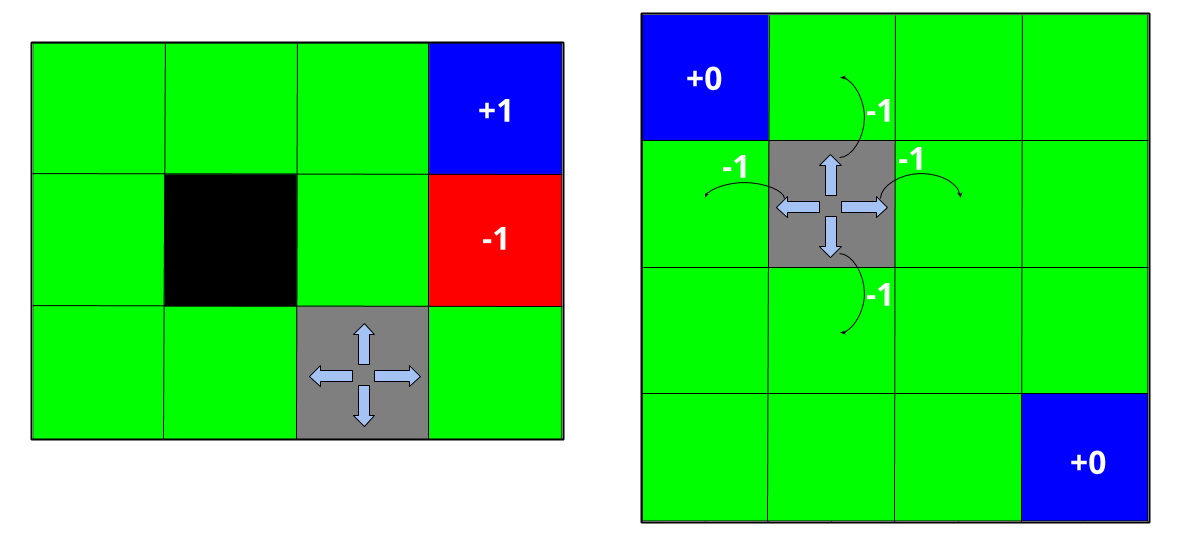
In order to make our DQN agent work in this simple gridworld we just had to modify the preprocess function such that each discrete state of the gridworld is converted into a one-hot encoding state-vector representation for our network, as shown in the following image.
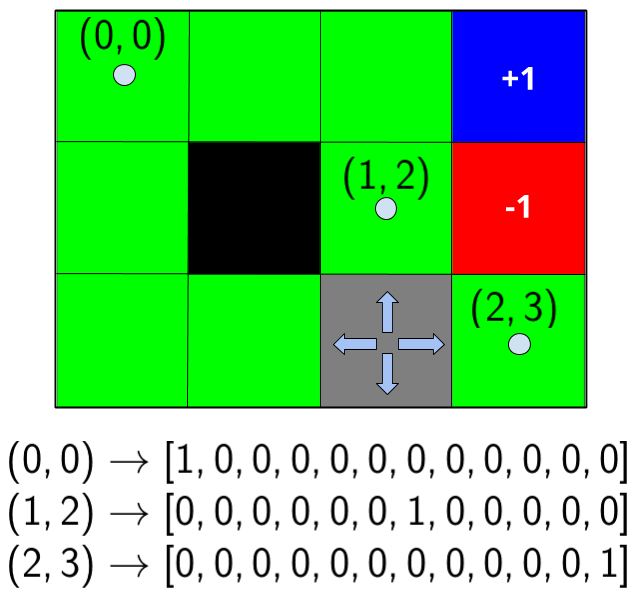
After fixing our implementation, this is what we obtained as the Q-table, constructed by evaluating the Q-network in the gridworld discrete states, which is what were expecting (what tabular q-learning also returned for the same configurations).
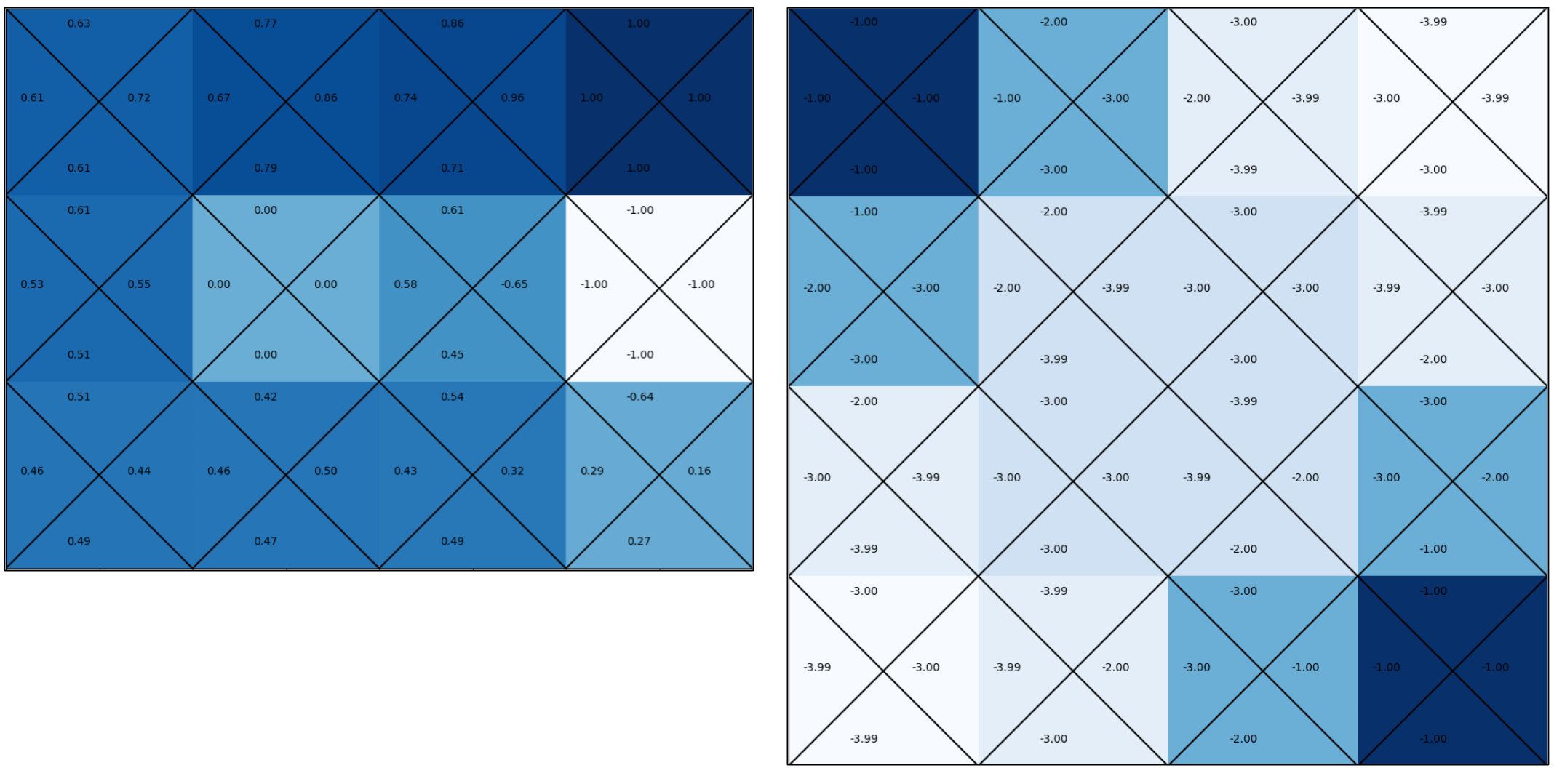
To train this, just use the trainer_full.py file (provided in the navigation package) as follows (for testing just replace "train" with "test" once training is complete):
# train a DQN-based agent with a MLP-model to solve gridworld
python trainer_full.py train --gridworld=true
# ... After training is completed
# test the trained model
python trainer_full.py test --gridworld=true
We then tried our implementation with some of the gym environments, specifically the Lunar Lander environment. Our implementation worked correctly on this environment after the fixes to the issues found using the gridworld test-case. The hyperparameters were set to roughly the same values found on the baseline of the Udacity DQN example. An example of the working agent is shown below:
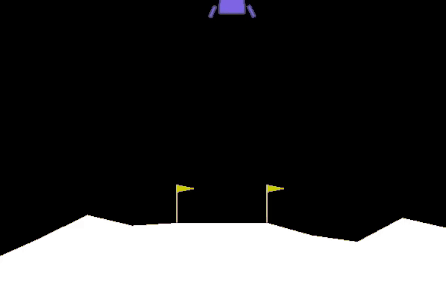
To train this, just use the trainer_full.py as well in the following way (for testing just replace "train" with "test" once training is complete):
# train a DQN-based agent with a MLP-model to solve LunarLander-v2
python trainer_full.py train --gym=LunarLander-v2
# ... After training is completed
# test the trained model
python trainer_full.py test --gym=LunarLander-v2
Finally, we also tried to visualize the decision making process during runtime, so we made some simple visualization helpers to plot the Q-values for each action, and the V-value for each state (following the greedy policy).

5.2 Choosing hyperparameters
The hyperparameters were tuned from the starting hyperparameters of the DQN solution provided for the Lunar Lander. We didn't run exhaustive tests (neither grid nor random search) to tune the hyperparameters, but just incrementally increased/decreased some hyperparameters we considered important:
Replay Buffer size: too low of a replay buffer size (around \( 10^{4} \)) gave us poor performance even though we made various changes in the other hyperparameters to make it work. We then decided to gradually increase it until it could more or less solve the task, and finally set it at around \( 10^{5} \) in size.
Epsilon schedule: We exponentially decreased exploration via a decay factor applied at every end of episode, and keeping \( \epsilon \) fixed thereafter. Low exploration over all training steps led to poor performance, so we gradually increased it until we started getting good performance. The calculations we made to consider how much to increase were based on for how long would the exploration be active (until fixed at a certain value), how many training steps were available and how big was our replay buffer.
All other hyperparameters were kept roughly to the same values as the baseline provided by the DQN solution from Udacity, as based on these values they provided some initial training curves that showed that with their configuration we should be able to get good results.
The max. number of steps was kept fixed to the baseline value provided, as they showed that at max. 1800 steps a working solution should be able to already solve the task.
The learning rate and soft-updates factor was kept also the same as the baseline, as we consider these values to be small enough to not introduce instabilities during learning. We actually had an issue related to a wrong interpolation which made learning stable for test cases like lunar lander, but unstable for the banana environment. We were using as update rule \(\theta^{-} := \tau \theta^{-} + (1-\tau) \theta\), but the correct update rule was \(\theta^{-} := (1-\tau) \theta^{-} + \tau \theta\). As we were using a very small \(\tau\), we were effectively running our experiements with hard-updates at a very high frequency (1 update per 4 steps) instead of soft-updates. This seemed to be working fine for the Lunar Lander environment (we increased \(\tau\) to make it work), but didn't work at all in the banana environment.
The minibatch size was kept the same (64). As we are not using any big network nor using high dimensional inputs (like images) we don't actually have to worry much about our GPU being able to allocate resources for a bigger batch (so we could have set a bigger batch size), but we decided it to keep it that way. It would be interesting though to see the effect that the batch size has during learning. Of course, it'd take a bit longer to take a SGD step, but perhaps by taking a "smoother" gradient step we could get better/smoother learning.
The hyperparameters chosen for our submission (found in the config_submission.json file) are shown below:
"stateDim" : 37,
"nActions" : 4,
"epsilonStart" : 1.0,
"epsilonEnd" : 0.01,
"epsilonSteps" : -1,
"epsilonDecay" : 0.9975,
"epsilonSchedule" : "geometric",
"lr" : 0.0005,
"minibatchSize" : 64,
"learningStartsAt" : 0,
"learningUpdateFreq" : 4,
"learningUpdateTargetFreq" : 4,
"learningMaxSteps" : 2000,
"replayBufferSize" : 100000,
"discount" : 0.999,
"tau" : 0.001,
"seed" : 0,
"useDoubleDqn" : false,
"usePrioritizedExpReplay" : false,
"useDuelingDqn" : false
6. Results of DQN on the Banana Collector Environment
In this section we show the results of our submission, which were obtained through various runs and with various seeds. The results are presented in the form of time series plots each over a single run, and standard deviation plots over a set of similar runs. We will also show the results of one of three experiments we made with different configurations. This experiment did not include the improvements (DDQN, PER), which are going to be explained in a later section. The results can be found also in the results_analysis.ipynb. However, due to the size of the training sessions, we decided not to upload most of the results (apart from a single run for the submission) due to the file size of the combined training sessions. Still, to reproduce the same experiments just run the provided bash scripts:
- training_submission.sh : to run the base experiments for the submissions
- training_tests_1.sh : to run the first experiment, related to \( \epsilon \) tests
- training_tests_2.sh : to run the second experiment, related to how much the improvements (DDQN and PER) to DQN help.
- training_tests_3.sh : to run the third experiment, to check if our implementations of DDQN and PER actually helps in some setups with little exploration.
6.1 Results with the configuration for the submission
- Single runs: We choose one of the results of the various runs, plotted as time series plots. The x-axis represents episodes (during training) and the y-axis represents the score obtained at that episode. Also, the noisy blue plot is the actual score per episode, whereas the red curve is a smoothed (running average) curve from the previous one with a window of size 100. Below we show one random run from the episode (not cherry-picked) for both our pytorch and tensorflow implementations. As we can see, the agent successfully solves the environment at around episode 900. Note that this submission configuration is not the best configuration (hyperparameters tuned to squeeze the most score out of the environment), but a configuration we considered appropriate (moderate exploration). We found that for more aggressive exploration schedules (fast decay over around 300 episodes) and a moderate sized replay buffer the task could be solved in around 300 steps (see experiment 1 later).
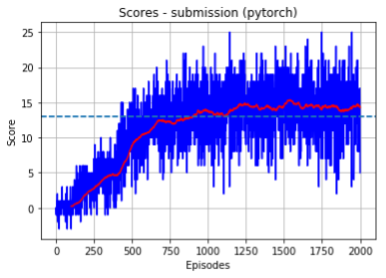
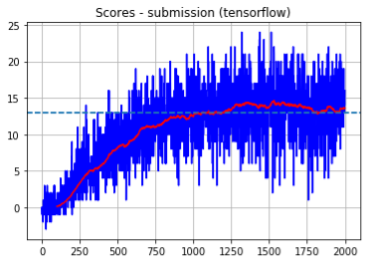
- All runs: Below we shows graphs of all runs in a single plot for three different random seeds. We again present one graph for each backend (pytorch and tensorflow). We recorded 5 training runs per seed. Recall again that all runs correspond to the same set of hyperparameters given by the config_submission.json file.
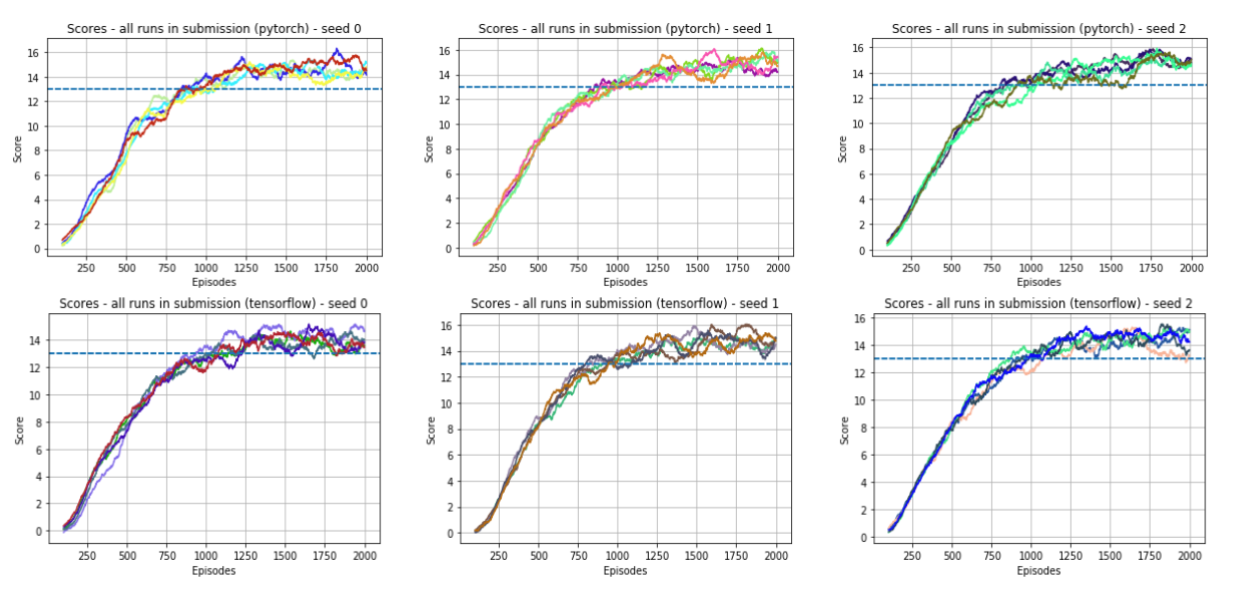
- Std-plots: Finally, we show the previous plots in the form of std-plots, which try to give a sense of the deviation of the various runs. We collected 5 runs per seed, and each std-plot is given for a specific seed. Recall again that all runs correspond to the same set of hyperparameters given by the config_submission.json file.
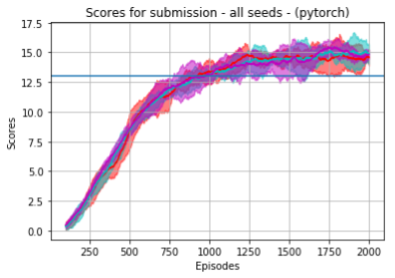
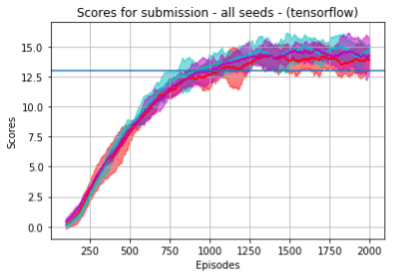
6.2 Experiment 1: tweaking exploration
In this experiment we tried to double-check if decreasing the amount of exploration would allow the agent to solve the task in fewer episodes. Because the amount of exploration is small, the agent would be forced to start trusting more its own estimates early on and, if the setup is right (big enough replay buffer, etc.), this might have the effect of making the agent solve the task quickly. The configurations used are the following:
config_agent_1_1.json : This configuration has a moderate exploration schedule. We decay \( \epsilon \) from 1.0 to 0.01 using a multiplicative decay factor of 0.9975 applied per episode. This schedule makes \( \epsilon \) decay from 1.0 to approx. 0.1 over 1000 episodes, and to the final value of 0.01 over approx. 1600 episodes.
config_agent_1_2.json : This configuration has a little more aggresive exploration schedule. We decay \( \epsilon \) from 1.0 to 0.01 using a multiplicative decay factor of 0.98 applied per episode. This schedule makes \( \epsilon \) decay from 1.0 to approx. 0.1 over 100 episodes, and to the final value of 0.01 over approx. 200 episodes.
Below we show the training results from 5 runs over 2 random seeds using these configurations. These plots reveal a trend which suggests that with the second configuration (less exploration) we get to solve the task faster (around 400 episodes) than the first configuration (around 900 episodes).
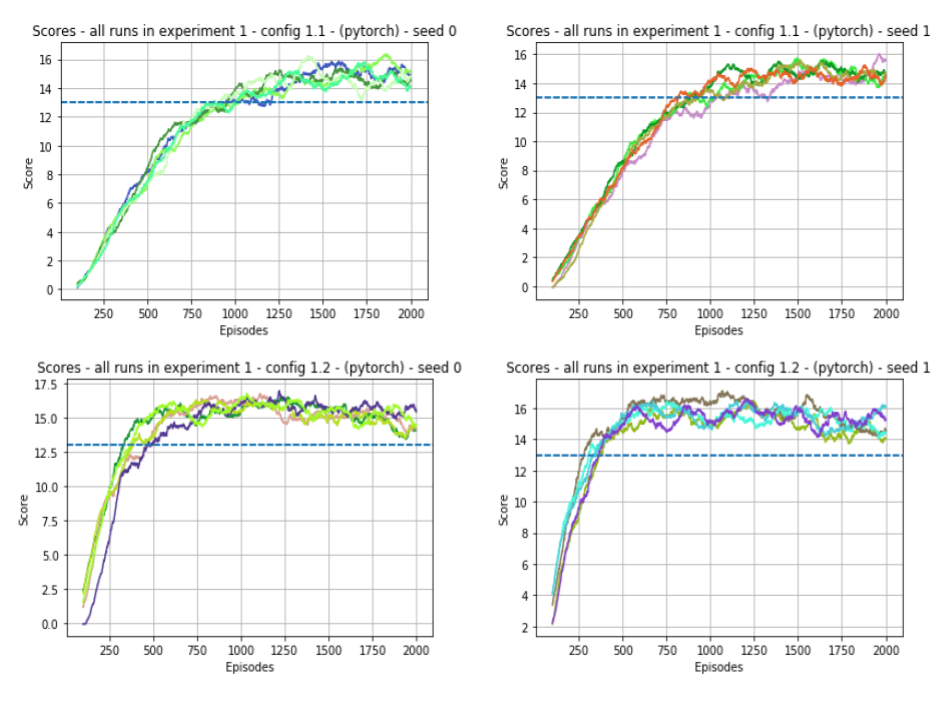
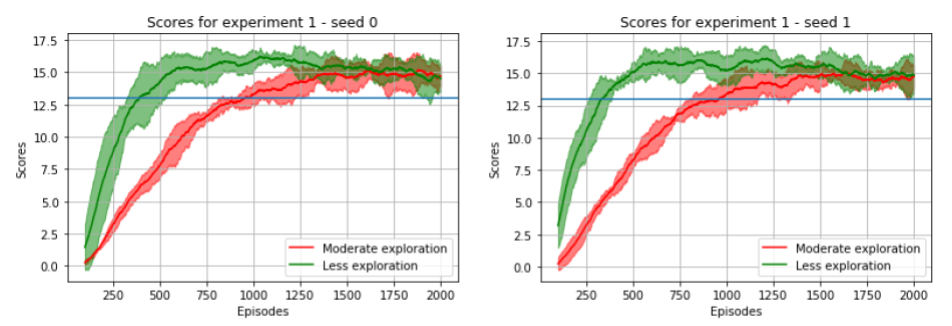
7. An overview of the improvements to vanilla DQN
After completing the base DQN implementation I decided to try implementing the improvements mentioned in the lectures, namely: Double DQN, Prioritized Experience Replay, and Dueling DQN. So far, we have implemented the first two, and in this section we will discuss them both.
7.1 Double DQN
This improvement tries to deal with the overestimation of the action-values that are used for the TD-targets. Recall the targets calculation from vanilla DQN:
\[ TD_{targets} = r + \gamma \max_{a'}Q(s',a';\theta^{-}) \]
By definition, we can rewrite this equation as follows :
\[ TD_{targets} = r + \gamma Q(s',\argmax_{a'}Q(s',a';\theta^{-});\theta^{-}) \]
These two eqs. are equivalent because we are evaluating the Q-value for the greedy action (second eq.), which is the same as taking the max. Q-value over all actions (first eq.). Let's make the components of the equation even clearer, by identifying each term:
\[ TD_{targets} = r + \gamma \underbrace{Q(s',\overbrace{\argmax_{a'}Q(s',a';\theta^{-})}^{\text{Action chosen to be the best}};\theta^{-})}_{q_{best}:\text{Q-value for the "best" action}} \]
The issue with this evaluation comes from evaluating q-values for actions chosen to be the best in specific steps during training, which might not be the best. Also even if these actions are actually the best actions, we still could overestimate its value because the network that evaluates it might just not be fully trained properly (which happens in early stages of training).
To avoid this issue of overestimation the authors of [11] introduced the idea of Double DQN, which builds on top of the idea of Double Q-learning introduced by Van Hasselt [10]. The idea consists of using two function approximators to compute the TD-targets, instead of just one, as shown in the following equation.
\[ TD_{targets} = r + \gamma \underbrace{Q(s',\overbrace{\argmax_{a'}Q(s',a';\theta)}^{\text{Chosen using $Q_{\theta}$}};\theta^{-})}_{\text{Evaluated using $Q_{\theta^{-}}$}} \]
Some visualizations from [11] are shown below, which show the effect of overestimation when using function approximation (in a simple test problem) and how Double Q-learning can potentially fix these issues. The test problem consists on a continuous state-space with just 1 dimension (shown along x-axis) and a discrete action space with 10 actions. The problem is set up such that all actions have the same true value equal to the optimal value ( \( Q^{\star}(s,a) = V^{\star}(s), \forall a \in \mathbb{A} \) ). The estimates are built using polinomials of 6th degree fitted to samples of the optimal Q-value function at various points of the state space. Rows represent cases with different \( Q^{\star} \), whereas columns represent the study of overestimation.

As suggested in [11], the easiest addition we can make to our code is to use both action-value and target action-value networks for Double DQN, using the action-value network for computing the greedy action, and the target network to evalue the q-value for this action. A snippet of these changes (from the agent.py file) that implements the required steps is shown below:
if self._useDoubleDqn :
# targets are computed in the following way
#
#
# q-target = r + gamma * Q( s', argmax( Q(s',a';theta) ); theta )
# ^ a' actor target
# |
# | ^
# qvalue from target model |
# |
# greedy action from actor model
# compute qvalues from both actorModel and targetModel
_qvals_actorModel_s = self._qmodel_actor.eval( _nextStates )
_qvals_targetModel_s = self._qmodel_target.eval( _nextStates )
# greedy actions
_argmaxActions = np.argmax( _qvals_actorModel_s, 1 ).reshape( -1, 1 )
# compute qtargets from the qvals of target network, ...
# using greedy actions from the actor network
_qtargets = _rewards + ( 1 - _dones ) * self._gamma * \
np.squeeze( np.take_along_axis( _qvals_targetModel_s, _argmaxActions, axis = 1 ) )
else :
# targets are just computing the target network
_qtargets = _rewards + ( 1 - _dones ) * self._gamma * \
np.max( self._qmodel_target.eval( _nextStates ), 1 )
7.2 Prioritized Experience Replay
So far we have been sampling uniformly from the replay buffer, regardless of how important the experience tuples might be for training, which seems not intuitive as during our experiences with the world there might be some experiences that could help us learn the most (kind of life lessons). Prioritized Experience Replay (PER), introduced in [12], is a heuristic that tries to solve this problem by adding some priority to certain experience tuples in the replay buffer, and then sample them according to these priorities.
So, instead of sampling uniformly from the replay buffer:
\[ \left \{ ( s_{j}, a_{j}, r_{j+1}, a_{j+1} ) \right \} \sim D_{vanilla} \]
PER samples in a prioritized way from the replay buffer:
\[ \left \{ ( s_{j}, a_{j}, r_{j+1}, a_{j+1}, w_{j} ) \right \} \sim D_{prioritized} \]
There are various details that have to be considered in order to implement PER, namely:
- What measure should we use for the priorities?
- Why is there a \( w_{j} \) in the returned samples?
- How do we add priorities to the replay buffer, and how do we sample?
These details are related to (respectively):
- Computing priorities from Bellman Errors.
- Importance Sampling (we have to fix a distribution mismatch).
- An efficient implementation for the prioritized buffer.
Computing priorities
The measure we will use to compute priorities are the Bellman Errors (or TD-Errors), whose expression is shown below (without the double dqn improvement):
\[ \delta = r + \gamma \max_{a'} Q(s',a';\theta^{-}) - Q(s,a;\theta) \]
This makes sense as a measurement because if the errors are big, then that is a measure of how off are our estimates. For the case that we had an oracle (true q-values for the targets), these errors are the actual values we have to be close to. In our case, we are using estimates with the target network, but these still give some similar information. Moreover, the targets at almost terminal states (1-step before terminal) reduce to the actual returns from those states, so if they are in the replay buffer, and the error is big for them, we should use them with more priority. So, we have the following measure for our priorities, using the absolute value of the Bellman Error:
\[ p_{t} = \vert \delta_{t} \vert \]
Thus, we can sample using this priorities by defining the following probability for each sample:
\[ P(j) = \frac{p_{j}}{\sum_{k}p_{k}} \]
A slight issue comes when the TD-error is very small (or even zero). This makes the sampling process avoid picking experiences that have small TD-error (or even not picking them at all if zero). So, to avoid this issue a small positive amount of priority is added to ensure the priorities don't become zero, as shown in the equation below.
\[ p_{t} = \vert \delta_{t} \vert + e \]
Finally, to control how much we let the priority affect the sample probabilities a hyperparameter \( \alpha \) is introduced as follows:
\[ P(j) = \frac{p_{j}^{\alpha}}{\sum_{k}p_{k}^{\alpha}} \]
Sampling from a different distribution
Because we are sampling using the priorities, we are effectively sampling from another distribution (other than the uniform distribution). Notice that the priorities will make some samples come more frequently than others. Also, try to visualize how the distribution changes from uniform to a distribution with peaks that depend on the priorities.
Recall our objective, which was defined as an expectation:
\[ L(\theta) = \mathbb{E}_{(s,a,r,s') \sim D} \left \{ ( r + \gamma \max_{a'} Q_{\theta^{-}}(s',a') - Q_{\theta}(s,a) )^{2} \right \} \]
To effectively remove the mismatch in distributions we have to make use of Importance Sampling as follows:
\[ L(\theta) = \mathbb{E}_{(s,a,r,s') \sim D_{prioritized} } \left \{ \frac{p(D)}{p(D_{prioritized})} ( r + \gamma \max_{a'} Q_{\theta^{-}}(s',a') - Q_{\theta}(s,a) )^{2} \right \} \]
The ratio \( w = \frac{p(D)}{p(D_{prioritized})} \) is the weight that has to be applied to correct for this mismatch, and it's computed from the probability that a sample is drawn from the buffer uniformly \( p(D) \), and the probability that a sample is drawn from the buffer using priorities \( p(D_{prioritized}) \). These weights can then be used to compute a modified loss function. As we will see in the implementation section later, instead of directly using the Mean Square Error loss from our DL package, we will make a modified loss to take into account importance sampling weights.
Data structure for sampling and storing with priorities
For the replay buffer from vanilla DQN we used a simple deque (or we could have also use a big numpy array an keep track of a buffer indexing variable). To support sampling using priorities the authors of [12] give two possible implementations (see Appendix B.2.1 from [12]):
- Rank-based prioritization: This implementation makes use of a priority queue built using a binary heap.
- Proportional prioritization: This implementation uses a "sum-tree" data structure.
We will use the second implementation, and explain how the datastructure works to enable efficient storing and sampling using priorities. This makes use of a Sum Tree, which is a specific case of a Segment Tree data structure, which consists of (quoting the previous linked resource):
"A Segment Tree is basically a binary tree used for storing intervals or segments. Each node in the segment Tree represents an interval"
An example of a Segment Tree is shown below:
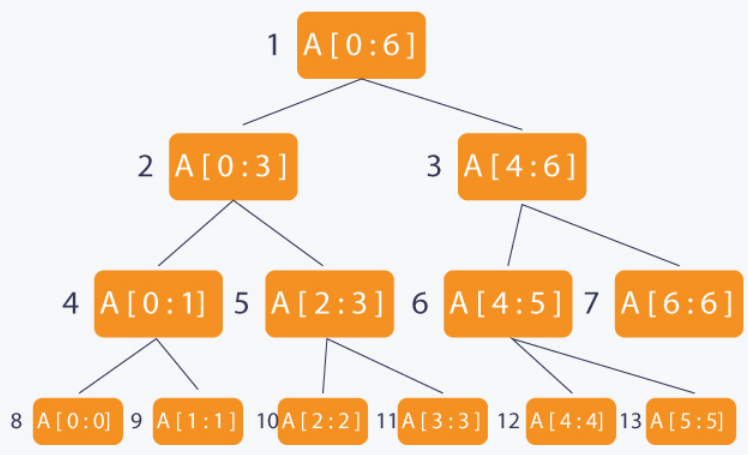
As you can see from the figure, each node in the tree represents an interval. Because it's a binary tree, we can efficiently query and update specific interval in O(log n), and worst case O(n) if the tree is unbalanced.
We can make use of this property of querying intervals to make efficient samples using priorities, where each interval at the leaves would consist of the priorities each leave has. The Segment Tree used for this case is a Sum Tree, which implements a Segment Tree with a sum operator that stores in each node the sum of its children. An example of such sum tree is shown below :
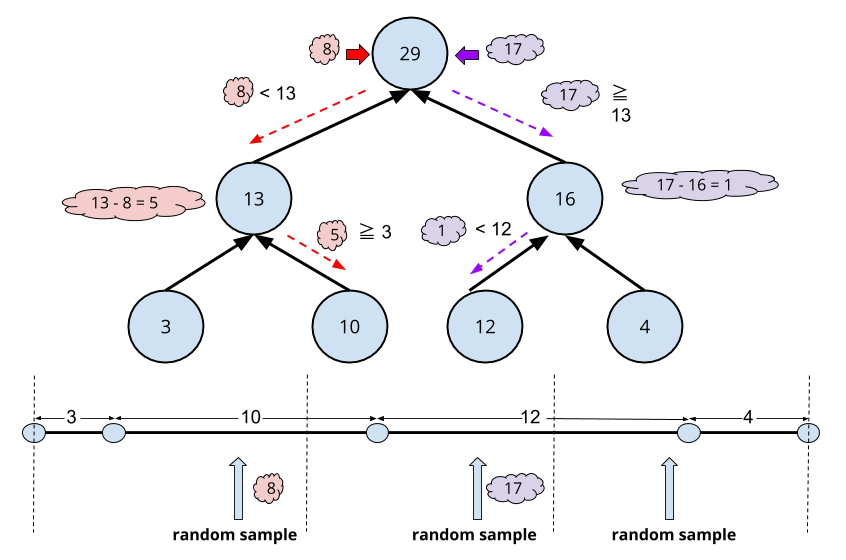
From the figure we could also see that in order to sample using the priorities in the leaves of the tree we essentially divide the whole segment composed of the unions of the priorities as segments into a number of bins required by the number of samples that we want to take (3 in that case). This effectivetly let's us sample using the priorities because each priority becomes a segment, and the chance of a random sample in a bin to land in that segment is proportional to the length of the segment.
The Sum Tree let's us query in which interval a given random number will land, by searching through the nodes of the tree until the required leave is found (corresponding to the interval in which the sample will land in the union of segments view).
Finally, updates can also be made to the tree when new priorities are available, i.e. when new bellman errors are computed for a minibatch. Notice that we are updating priorities over the minibatch only, and not the whole elements in the prioritized replay buffer, which is discussed in section 3.3 on Stochastic Prioritization in [12].
Implementation
The full implementation of PER is distributed over four files:
segmentree.py, which implements the Segment Tree, Sum Tree, and Min Tree (used for keeping track of the min priority) data structures. This implementation was based on OpenAI baselines [14], and in this and this two implementations. We kept a MinTree as in the OpenAI baselines implementation to be consistent with their implementation. However, I think we could have just kept a variable updated with the min at each update of the priorities as well.
prioritybuffer.py, which implements the prioritized replay buffer. It was also based on the three resources mentioned above.
agent.py, which has a slight modification for the learning method to take into account importance sampling.
model_pytorch.py, which implements the required modifications to the loss function when using PER.
We will focus mainly in the implementation of the priority buffer, the changes made to the agent base code and the changes made to the model. I'd suggest the reader to refer to the resources about the segmentree and the implementation (this one and the others as well) to fully understand the sumtree and mintree data structures. Some tests of the segmentTree, sumTree and minTree can be found in the tests.ipynb notebook at the root of the provided package.
The key methods in the priority buffer are the __init__ add, sample and updatePriorities methods, which we will analyze one by one.
- The constructor ( __init__ ) instantiates the prioritized replay buffer by copying the required hyperparameters, namely: \( e \) extra amount for priority (recall \( p_{t} = \vert \delta_{t} \vert + e \) ), \( \alpha \) power to control how priority affects the sample probability, \( \beta \) power to control the amount of importance sampling used (annealed from given value up to 1), and the amount \( \Delta \beta \) that the \( \beta \) factor increases every sampling call. We also create the Sum Tree and the Min Tree as required for the sampling and importance sampling calculation process.
def __init__( self,
bufferSize,
randomSeed,
eps = 0.01,
alpha = 0.6,
beta = 0.4,
dbeta = 0.00001 ) :
super( DqnPriorityBuffer, self ).__init__( bufferSize, randomSeed )
# hyperparameters of Prioritized experience replay
self._eps = eps # extra ammount added to the abs(tderror) to avoid zero probs.
self._alpha = alpha # regulates how much the priority affects the probs of sampling
self._beta = beta # regulates how much away from true importance sampling we go (up annealed to 1)
self._dbeta = dbeta # regulates how much we anneal up the previous regulator of importance sampling
# a handy experience tuple constructor
self._experience = namedtuple( 'Step',
field_names = [ 'state',
'action',
'reward',
'nextState',
'endFlag' ] )
# sumtree for taking the appropriate samples
self._sumtree = segmentree.SumTree( self._bufferSize )
# mintree for taking the actual min as we go
self._mintree = segmentree.MinTree( self._bufferSize )
# a variable to store the running max priority
self._maxpriority = 1.
# a variable to store the running min priority
self._minpriority = eps
# number of "actual" elements in the buffer
self._count = 0
- The add method adds an experience tuple to the buffer. We create the experience object (data of the leaves of the trees), and add it to both the Sum Tree and the Min Tree with maximum priority (as we want to make sure new experiences have a better chance of being picked at least once).
def add( self, state, action, nextState, reward, endFlag ) :
"""Adds an experience tuple to memory
Args:
state (np.ndarray) : state of the environment at time (t)
action (int) : action taken at time (t)
nextState (np.ndarray) : state of the environment at time (t+1) after taking action
reward (float) : reward at time (t+1) for this transition
endFlag (bool) : flag that indicates if this state (t+1) is terminal
"""
# create a experience object from the arguments
_expObj = self._experience( state, action, reward, nextState, endFlag )
# store the data into a node in the smtree, with nodevalue equal its priority
# maxpriority is used here, to ensure these tuples can be sampled later
self._sumtree.add( _expObj, self._maxpriority ** self._alpha )
self._mintree.add( _expObj, self._maxpriority ** self._alpha )
# update actual number of elements
self._count = min( self._count + 1, self._bufferSize )
- The sample method is the most important one, as it is in charge of sampling using the Sum Tree and computing the importance sampling weights using both the Sum Tree and Min Tree. As explained earlier, the sampling process consists of sampling random numbers inside bins over the whole union of priorities by querying the Sum Tree with these random numbers. The importance sampling weights are computed as explained earlier, and returned along the corresponding experience tuple for usage in the SGD process during learning. We also return the indices in the tree that correspond to these samples for later updates, as the Bellman Errors will be computed for these experiences and updated after the SGD step has been taken (shown later in the modifications to the core agent functionality).
def sample( self, batchSize ) :
"""Samples a batch of data using consecutive sampling intervals over the sumtree ranges
Args:
batchSize (int) : number of experience tuples to grab from memory
Returns:
(indices, experiences) : a tuple of indices (for later updates) and
experiences from memory
Example:
29
/ \
/ \
13 16
| | | |
3 10 12 4 |---| |----------| |------------| |----|
3 10 12 4
^______^______^_______^_______^_______^
* * * * * *
5 samples using intervals, and got 10, 10, 12, 12, 4
"""
# experiences sampled, indices and importance sampling weights
_expBatch = []
_indicesBatch = []
_impSampWeightsBatch = []
# compute intervals sizes for sampling
_prioritySegSize = self._sumtree.sum() / batchSize
# min node-value (priority) in sumtree
_minPriority = self._mintree.min()
# min probability that a node can have
_minProb = _minPriority / self._sumtree.sum()
# take sampls using segments over the total range of the sumtree
for i in range( batchSize ) :
# left and right ticks of the segments
_a = _prioritySegSize * i
_b = _prioritySegSize * ( i + 1 )
## _b = min( _prioritySegSize * ( i + 1 ), self._sumtree.sum() - 1e-5 )
# throw the dice over this segment
_v = np.random.uniform( _a, _b )
_indx, _priority, _exp = self._sumtree.getNode( _v )
# Recall how importance sampling weight is computed (from paper)
#
# E { r } = E { p * r } = E { w * r } -> w : importance
# r~p r~p' - r~p' sampling
# p' weight
#
# in our case:
# p -> uniform distribution
# p' -> distribution induced by the priorities
#
# 1 / N
# w = ____
#
# P(i) -> given by sumtree (priority / total)
#
# for stability, the authors scale the weight by the max-weight ...
# possible, which is (because maximizing a fraction minimizes the ...
# denominator if the numrerator is constant=1/N) the weight of the ...
# node with minimum probability. After some operations :
#
# b b
# w / wmax = ((1/N) / P(i)) / ((1/N) / minP(j))
# j
# b -b
# w / wmax = ( min P(j) / P(i) ) = ( P(i) / min P(j) )
# j j
# compute importance sampling weights
_prob = _priority / self._sumtree.sum()
_impSampWeight = ( _prob / _minProb ) ** -self._beta
# accumulate in batch
_expBatch.append( _exp )
_indicesBatch.append( _indx )
_impSampWeightsBatch.append( _impSampWeight )
# stack each experience component along batch axis
_states = np.stack( [ exp.state for exp in _expBatch if exp is not None ] )
_actions = np.stack( [ exp.action for exp in _expBatch if exp is not None ] )
_rewards = np.stack( [ exp.reward for exp in _expBatch if exp is not None ] )
_nextStates = np.stack( [ exp.nextState for exp in _expBatch if exp is not None ] )
_endFlags = np.stack( [ exp.endFlag for exp in _expBatch if exp is not None ] ).astype( np.uint8 )
# convert indices and importance sampling weights to numpy-friendly data
_indicesBatch = np.array( _indicesBatch ).astype( np.int64 )
_impSampWeightsBatch = np.array( _impSampWeightsBatch ).astype( np.float32 )
# anneal the beta parameter
self._beta = min( 1., self._beta + self._dbeta )
return _states, _actions, _nextStates, _rewards, _endFlags, _indicesBatch, _impSampWeightsBatch
- The updatePriorities method is in charge of updating the priorities of the sampled experiences using the new Bellman Errors computed during the SGD learning step.
def updatePriorities( self, indices, absBellmanErrors ) :
"""Updates the priorities (node-values) of the sumtree with new bellman-errors
Args:
indices (np.ndarray) : indices in the sumtree that have to be updated
bellmanErrors (np.ndarray) : bellman errors to be used for new priorities
"""
# sanity-check: indices bath and bellmanErrors batch should be same length
assert ( len( indices ) == len( absBellmanErrors ) ), \
'ERROR> indices and bellman-errors batch must have same size'
# add the 'e' term to avoid 0s
_priorities = np.power( absBellmanErrors + self._eps, self._alpha )
for i in range( len( indices ) ) :
# update each node in the sumtree and mintree
self._sumtree.update( indices[i], _priorities[i] )
self._mintree.update( indices[i], _priorities[i] )
# update the max priority
self._maxpriority = max( _priorities[i], self._maxpriority )
The key changes made to the agent core functionality are located in the learn method.
- We first just sample using the priority buffer, which returns also the importance sampling weights to be use later in the SGD step (see line 221).
# get a minibatch from the replay buffer
_minibatch = self._rbuffer.sample( self._minibatchSize )
if self._usePrioritizedExpReplay :
_states, _actions, _nextStates, _rewards, _dones, _indices, _impSampWeights = _minibatch
else :
_states, _actions, _nextStates, _rewards, _dones = _minibatch
- We then just execute the training step on the action-value network as usual, with the slight addition of the importance sampling weights. After this step, we grab the Bellman Errors computed inside the model's functionality and use them to update the priorities of the sampled experiences in the minibatch (see line 277).
# make the learning call to the model (kind of like supervised setting)
if self._usePrioritizedExpReplay :
## if np.sum( _rewards ) > 0. :
## set_trace()
# train using also importance sampling weights
_absBellmanErrors = self._qmodel_actor.train( _states, _actions, _qtargets, _impSampWeights )
# and update the priorities using the new bellman erros
self._rbuffer.updatePriorities( _indices, _absBellmanErrors )
else :
# train using the normal data required
self._qmodel_actor.train( _states, _actions, _qtargets )
Finally, the key changes made to the model are located in the initialize and train methods:
- The initialize method constructs the appropriate loss function for the case of using importance sampling (for PER) by making a custom MSE loss that includes the weights coming from importance sampling.
def initialize( self, args ) :
# grab current pytorch device
self._device = args['device']
# send network to device
self._nnetwork.to( self._device )
# create train functionality if necessary
if self._trainable :
# check whether or not using importance sampling
if self._useImpSampling :
self._lossFcn = lambda yhat, y, w : torch.mean( w * ( ( y - yhat ) ** 2 ) )
else :
self._lossFcn = nn.MSELoss()
self._optimizer = optim.Adam( self._nnetwork.parameters(), lr = self._lr )
- The train method takes into account the use of importance sampling by passing the importance sampling weights to an appropriate tensor and then calling the appropriate loss function. The bellman errors are computed by default (as we are saving them), but are only grabbed by the agent if using PER.
def train( self, states, actions, targets, impSampWeights = None ) :
if not self._trainable :
print( 'WARNING> tried training a non-trainable model' )
return None
else :
_aa = torch.from_numpy( actions ).unsqueeze( 1 ).to( self._device )
_xx = torch.from_numpy( states ).float().to( self._device )
_yy = torch.from_numpy( targets ).float().unsqueeze( 1 ).to( self._device )
# reset the gradients buffer
self._optimizer.zero_grad()
# do forward pass to compute q-target predictions
_yyhat = self._nnetwork( _xx ).gather( 1, _aa )
## set_trace()
# and compute loss and gradients
if self._useImpSampling :
assert ( impSampWeights is not None ), \
'ERROR> should have passed importance sampling weights'
# convert importance sampling weights to tensor
_ISWeights = torch.from_numpy( impSampWeights ).float().unsqueeze( 1 ).to( self._device )
# make a custom mse loss weighted using the importance samples weights
_loss = self._lossFcn( _yyhat, _yy, _ISWeights )
_loss.backward()
else :
# do the normal loss computation and backward pass
_loss = self._lossFcn( _yyhat, _yy )
_loss.backward()
# compute bellman errors (either for saving or for prioritized exp. replay)
with torch.no_grad() :
_absBellmanErrors = torch.abs( _yy - _yyhat ).cpu().numpy()
# run optimizer to update the weights
self._optimizer.step()
# grab loss for later statistics
self._losses.append( _loss.item() )
if self._saveGradients :
# grab gradients for later
_params = list( self._nnetwork.parameters() )
_gradients = [ _params[i].grad for i in range( len( _params ) ) ]
self._gradients.append( _gradients )
if self._saveBellmanErrors :
self._bellmanErrors.append( _absBellmanErrors )
return _absBellmanErrors
8. Some preliminary tests of the improvements
In this section we show some preleminary results obtained with the improvements. These results come from the following two extra experiments, which we made in order to evaluate if PER and DDQN helped during training:
- Experiment 2 : Test vanilla DQN against each of the improvements (DDQN only, PER only and DDQN + PER).
- Experiment 3 : Test if DDQN + PER help in situations with too little exploration. Our hypothesis was that too little exploration might run into unstable learning, and DDQN + PER could help stabilize this process (or even help solve it if the agent couldn't solve the task using only the baseline).
Note: the hyperparameters related to PER were not exposed through the .json file (sorry,I will fix it in later tests), but instead hard-coded in the priority-buffer implementation (see the prioritybuffer.py file). These parameters were set to the following default values:
eps : 0.01 # small value added to the absolute value of the bellman error
alpha : 0.6 # power to raise the priority in order to further control it
beta : 0.4 # importance sampling annealed factor
dbeta : 0.00001 # linear increment per sample added to the "beta" parameter
Spoiler alert: we did not find much improvement in the task at hand by using PER and DDQN. However, these results are preliminary as we did not tune the hyperparameters of PER (nor the other hyperparameters), and we still haven't made test cases for all details of the implementations of the algorithm. We tested each separate component of the improvements (extra data structures, consistency with other sources' implementations, etc.), but still we could have miss some detail in the implementation. Also, perhaps the structure of the task at hand is not too complicated for our vanilla DQN to require these improvements. We plan to make further tests and experiments in this and more complicated environments (visual banana environment, atari, etc.) to see if our improvements actually work and help during training.
8.1 Experiment 2: Testing DQN improvements against the baseline
This experiment consisted of testing what improvements do DDQN and PER offer to our vanilla DQN implementation. The configurations for these can be found in the following files:
- config_agent_2_1.json : Configuration with only DDQN active.
- config_agent_2_2.json : Configuration with only PER active.
- config_agent_2_3.json : Configuration with DDQN + PER active.
- config_agent_1_1.json : The baseline, with the same hyperparameters as the ones above.
We used 5 runs and 2 different seeds for each configuration of the experiment. The preliminary results (shown below) look very similar for all configurations, and we can't conclude if there is any improvement using the variations to vanilla DQN.
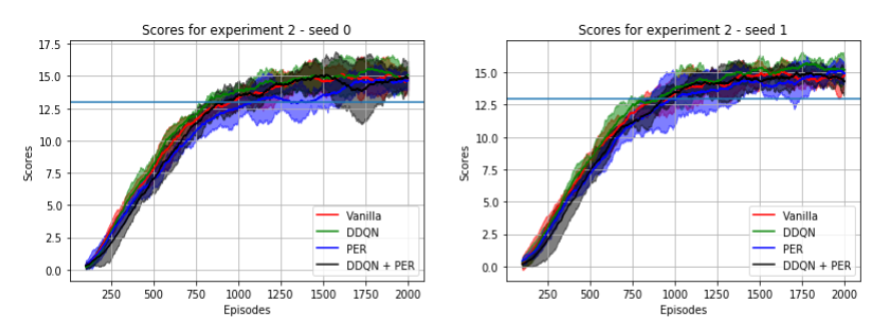
8.2 Experiment 3: Testing if DDQN + PER help when using too little exploration
This experiment consisted on testing if DDQN + PER would help in situations where there is too little exploration. The configurations used for these experiment can be found in the following files:
- config_agent_3_1.json : Configuration without DDQN nor PER.
- config_agent_3_2.json : Configuration with DDQN + PER active.
The exploration schedule was such that in just 60 episodes we would have reached the fixed 0.01 minimum value for \( \epsilon \), and have just 18000 experience tuples in a buffer of size of 131072, which consisted just of a approx. 13% of the replay buffer size. All other interactions would add only experience tuples taken from a practically greedy policy. Also, after just 510 episodes, the replay buffer would have just experience tuples sampled from a greedy policy.
We considered that this case would require clever use of the data (PER) to squeeze the most out of the experiences in the replay buffer, and also to not to overestimate the q-values, as we would be following a pure greedy policy after just some steps. The preliminary results don't show much evidence of improvement, except in a run with a different seed, in which the learning curves were less jumpy, indicating more stable learning. The results are shown in the image below, which were created using 5 runs with 2 seeds for both configurations.
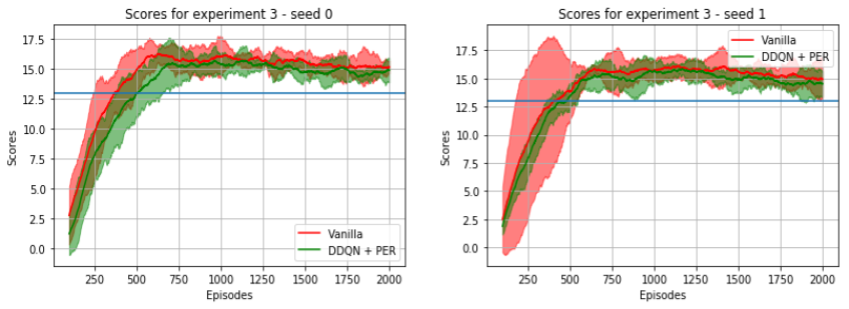
9. Final remarks and future improvements
In this post we tried to explain the DQN algorithm and how to use it to solve the banana environment collector task from the ml-agents package. We also implemented some improvements to the base DQN implementation, namely DDQN and PER. Some conclusions we can get from this project would be the following:
Deep reinforcement learning via DQN is a very interesting approach to solve control problems. Not control as in continuous control (which is a subject very close to my heart 😄), as we are dealing with only discrete action spaces. However, as we will see in the following projects, this approach of end-to-end learning of behaviours can be scaled up to this environments that require continuous state and action spaces (so stay tuned for the DDPG and PPO post for project 2 😄).
The additions made to action-value function approximation by the DQN authors are quite important. We mentioned a case in which we messed up the soft-updates and were effectively copying the full networks from one to another at a very high frequency (every 4 steps, almost every single step). This is very similar to the case of just using a single network (so no effective target-network). In a sense we did an ablation test without realizing it 😄 (my bad). I'll make more proper ablation tests as I update this post, like removing fixed-targets and removing the replay-buffer.
We also did not mentioned it in a proper section, but we got some interesting behaviour while working with the project. In some situations the agent got stuck during testing, trying to go left and then right, stuck in an loop from which it could not recover (those are the spikes that appear in the noisy plots, which appear very sporadically). This behaviour is kind of similar to how a state-machine of a game agent gets stuck because the programmer forgot to take into account some detail of the game (I've been there quite some times 😢). For this situation I just made the MLP bigger (give it a bigger high capacity model) and it started getting better performance and got stuck less often, kind of like having more "if-then soft rules" to work with that help take into account those details. This could be also caused because various states of the environment are aliased, as we only have ray-casting observations feed to a MLP, so perhaps using a recurrent model would help in this situation.
Also, there's some unexpected behaviour that we can see when we look at the q-values visualizations during testing (see Figure 20). We expected to see a clear differences between the max. q-value and the other q-values, but instead we can just see a small margin that defines the actual action to choose. We haven't run the visualizer into other environments to see if there's a clear distinction during inference, and we consider that this might be caused by the nature of the environment (lunar-lander), as perhaps in a given state you can actually get the same reward if any action is taken, given that the next states will give you different situations that might yield to more distinct q-values (imagine starting taking a bad action, but your policy let's you recover, and in this situations you see a clear difference). We will try to further analyze this in future updates to the post.
Finally, below we mention some of the improvements we consider making in following updates to this post:
Make more tests of the improvements implemented, namely DDQN and PER, as we did not see much improvement in the given task. We could run the implementation in different environments from gym and atari, make "unit tests" for parts of the implementation, and tune the hyperparameters (PER) to see if there are any improvements.
Get the visual-based agent working for the banana environment. We had various issues with the executable provided, namely memory leaks of the executable that used up all memory in my machine. I first thought they were issues with the replay buffer being to big (as the experiences now stored images), but after some debugging that consisted on checking the system-monitor and even only testing the bare unity environment in the most simple setting possible, i.e. just instantiating it and running a random policy in a very simple script, we still got leaks that did not let us fully test our implementation. I was considering sending a PR, but the leaks only occur using the old ml-agent API (called unityagents, which is version 0.4.0). We made a custom build in the latest version of unity ml-agents and the unity editor, and got it working without leaks, but still could not get the agent to learn, which might be caused by our DQN agent implementation, our model, or the custom build we made.
Finish the implementation of a generic model for tensorflow and pytorch (see the incomplete implementations in the model_pytorch.py and model_tensorflow.py files), in order to be able to just send a configuration easily via a .json file or similar, and instantiate the requested model without having to write any pytorch nor tensorflow specific model by ourselves.
Implement the remaining improvements from rainbow, namely Dueling DQN, Noisy DQN, A3C, Distributional DQN, and try to reproduce a similar ablation test in benchmarks like gym and ml-agents.
Implement recurent versions of DQN and test the implementation in various environments.
References
- [1] Sutton, Richard & Barto, Andrew. Reinforcement Learning: An introduction.
- [2] Mnih, Volodymyr & Kavukcuoglu, Koray & Silver, David, et. al.. Human-level control through deep-reinforcement learning
- [3] Achiam, Josh. Spinning Up in Deep RL
- [4] Simonini, Thomas. A Free course in Deep Reinforcement Learning from beginner to expert
- [5] Stanford RL course by Emma Brunskill
- [6] UCL RL course, by David Silver
- [7] UC Berkeley DeepRL course by Sergey Levine
- [8] Udacity DeepRL Nanodegree
- [9] DeepRL bootcamp
- [10] Van Hasselt, Hado. Double Q-learning
- [11] Van Hasselt, Hado & Guez, Arthur & Silver, David. Deep Reinforccement Learning with Double Q-learning
- [12] Schaul, Tom & Quan, John & Antonoglou, Ioannis & Silver, David. Prioritized Experience Replay
- [13] Hacker Earth. Segment Trees data structures
- [14] OpenAI. Baselines
- [15] Hessel, Matteo & Modayil, Joseph & van Hasselt, Hado & Schaul, Tom & Ostrovski, Georg & Dabney, Will & Horgan, Dan & Piot, Bilal & Azar, Mohammad & Silver, David Rainbow
- [16] Hausknecht, Matthew & Stone, Peter Deep Recurrent Q-Learning with Partially Observable MDPs